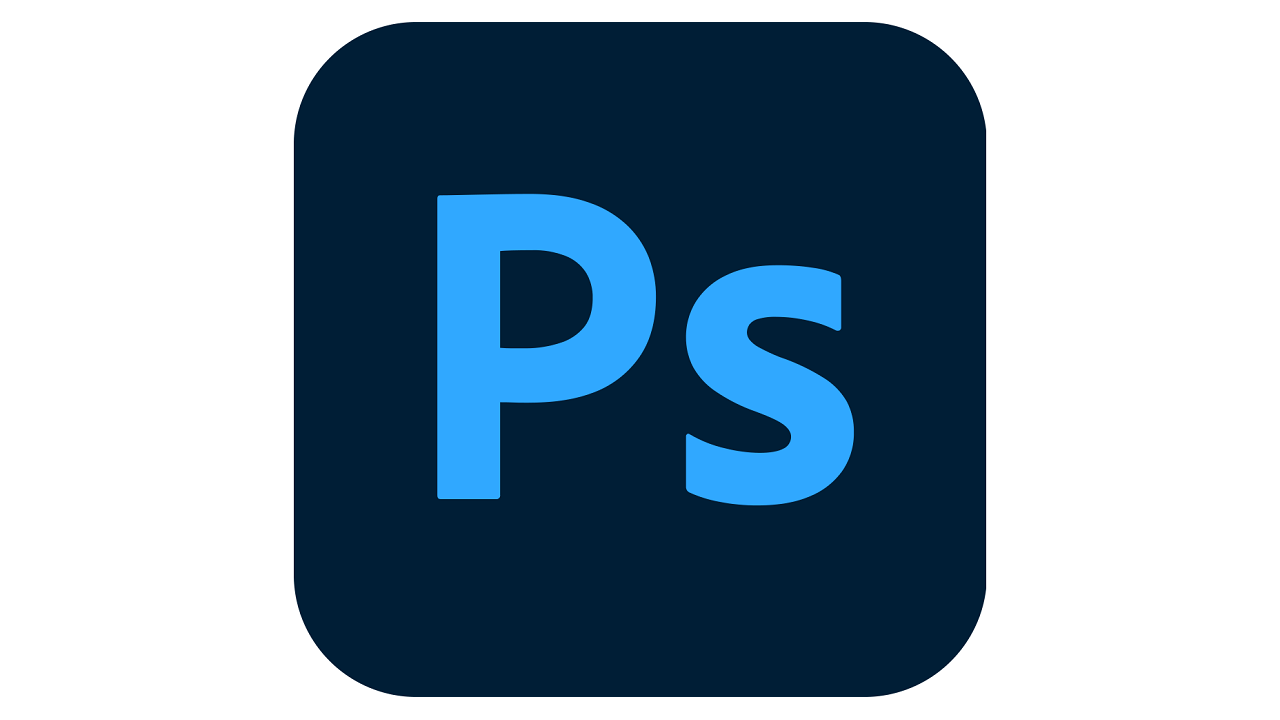-
Pros
- Vast set of photo correction and manipulation tools
- Cutting-edge generative AI features
- Slick user interface with a lot of guidance
- Mobile and web design capabilities
- Rich drawing and typography options
- Excellent raw camera file support
- Synced Libraries, Cloud Documents, and collaboration features
-
Cons
- No perpetual license option
- Runs many processes in the background
Adobe Photoshop Specs
| Content-Aware Edits | |
| Edits Raster Graphics | |
| Layer Editing | |
| Lens Profile Corrections | |
| Pricing Model | Subscription |
| Pro-Level Typography | |
| Touch Interface Support |
Photoshop started the digital image manipulation revolution more than 30 years ago, and Adobe's groundbreaking application continues to be the best photo editing software money can buy (or rent, to be more precise). If you need drawing, layered image editing, a multitude of effects, and typography, you need Photoshop. It simply provides designers and photographers alike the most—and the most advanced—tools for their craft. Adobe also frequently updates Photoshop with generative AI features, innovative capabilities that simplify difficult tasks, and support for new formats. Because of its class-leading functionality, polish, and usability, Photoshop earns a rare five-star rating and our Editors' Choice award.
How Much Does Photoshop Cost?
To get Photoshop, you need a Creative Cloud subscription. Pricing can be confusing, and finding the best deal on Adobe's site is hard. You can sign up for a Photoshop single-app plan for $22.99 per month (that's with an annual commitment, though you make payments monthly); this includes 100GB of online storage. If you opt for month-to-month payments, this plan costs $34.49 per month. If you prepay for a full year, it's $263.88, which works out to $21.99 per month.
But that's not the best you can do. The Photography (20GB) plan, which goes for $9.99 per month with an annual commitment, gets you Photoshop, Lightroom (our Editors' Choice winner for photo workflow software), and 10 Adobe Stock images. You need to hunt around the site to find that deal. When you get to the pricing page, make sure you click on the Photo section on the left side.
If you want Photoshop, Lightroom, and more online storage (1TB), you pay $19.99 per month, again with an annual commitment. A full Creative Cloud subscription, which gets you all the suite's design, photography, and video applications, costs $59.99 per month with an annual commitment.
You no longer have the option to buy a perpetual license for Photoshop. If you don't like the software-as-a-service model, consider Photoshop alternatives such as Corel's surprisingly capable PaintShop Pro ($99.99), CyberLink PhotoDirector ($99.99), or even Adobe's Photoshop Elements ($99.99 for a three-year license). If you don't want to pay a cent, you can use the free, open-source GIMP, though doing so can be a painful, counterintuitive experience if you're used to the convenience and polish of Photoshop.
What's New in Photoshop?
The latest features in Photoshop continue to use?Adobe's Firefly generative artificial intelligence?and its Sensei image-analyzing AI technology. The former powers Neural Filters like Color Transfer, Landscape Mixer, and Sky Replacement. The latter comes in the form of the Generative Expand, Generative Fill, and Generate Image tools. Firefly can generate images from text prompts or based on uploaded reference images.
The Adobe Max 2024 update, version 26 of Photoshop, adds (as you might expect) even more generative AI tools. Leading the pack is the new Distraction Removal feature, an option in the program’s Remove tool. Generative Expand, Generative Fill, and Generate Background also see improvements. Now, they deliver more realistic images and better match the lighting and perspective of your source material. The update adds OpenColorIO (OCIO) support too, which is of interest to production teams who need to match colors on different displays. Support for 32-bit HDR images and improvements to Photoshop's Camera Raw companion app (new AI features and more file support) round out the changes.
Prior to Max, the July 2024 update added an Adjustment Brush, bullets and numbering options for the Type tool, an Enhance Detail option for the AI-powered Generative Fill tool, and a Selection Brush. Some updates impacted the Camera Raw helper app, which provides the same Lens Blur tool and HDR editing and output capabilities of Lightroom and Lightroom Classic. Other impressive recent features include the AI-powered Remove Tool, Contextual Task Bar (improved in the latest update), Lightroom-like Adjustment Presets, and a smarter Gradient tool.
 (Credit: Adobe/PCMag)
(Credit: Adobe/PCMag)The?web-based version of Photoshop is getting close to parity with the desktop application. It supports generative AI features and raw camera files and even runs well on Chromebook Plus?computers. But it still lacks a few features, like Pen and Shape tools for vector paths and many filters.
How to Get Started With Photoshop?
To get Photoshop, you first install the Creative Cloud desktop program. This handles installations and updates, as well as syncs your files online. It also provides news about Adobe, the Behance creative social community, and stock images. The Creative Cloud utility lets you browse and easily install Photoshop plug-ins, too. Note that it installs a ton of background processes on your system, many of which run even when you're not using a Creative Cloud application. I counted no fewer than 11 processes in the Windows Task Manager running even when no Adobe software was ostensibly running and after I'd exited the Creative Cloud Manager app. Another annoyance is that the Creative Cloud app seems to require an update every time I open it.
 (Credit: Adobe/PCMag)
(Credit: Adobe/PCMag)Only install Photoshop on a fairly powerful PC or Mac. I tested on a Windows 11 PC sporting a 3.60GHz Intel Core i7-12700K, 16GB RAM, an Nvidia GeForce RTX 3060 Ti, and a 512GB Samsung PM9A1 PCIe 4.0 NVMe SSD. It requires 64-bit Windows 10 version 21H2 or later, 8MB RAM, and 4GB available disk space. It runs in Windows on Arm with the same requirements. Mac users must be running macOS 11 (Big Sur) or later with 8GB RAM and a GPU with Metal support. Apple silicon Macs can run Photoshop natively as long as they are on macOS 11.2.2 or later.
Photoshop has excellent touch input support for devices like the Microsoft Surface Pro. Adobe also maintains an almost fully functional iPad version. Not only does the program let you use touch to pan and zoom images, but it also recognizes gestures, such as a two-finger swipe to undo and a three-finger swipe to scroll through images. For painting with your finger, though, you might try Adobe's free Fresco app, available for iPhone, iPad, Microsoft Surface Pro devices.
A Surprisingly Understandable Interface
Despite the enormous number of tools inside the program, the interface is impressively user-friendly. Adobe continues to make Photoshop's interface more customizable and helpful. You can choose between several targeted workspace layouts, including Graphic and Web, Motion, Painting, and Photography, or you can create a custom layout of panels and windows. You can also rearrange the program's toolbar button rail to taste. A Neutral Color Mode option (thankfully) changes the bright blue Share button to a less distracting gray.
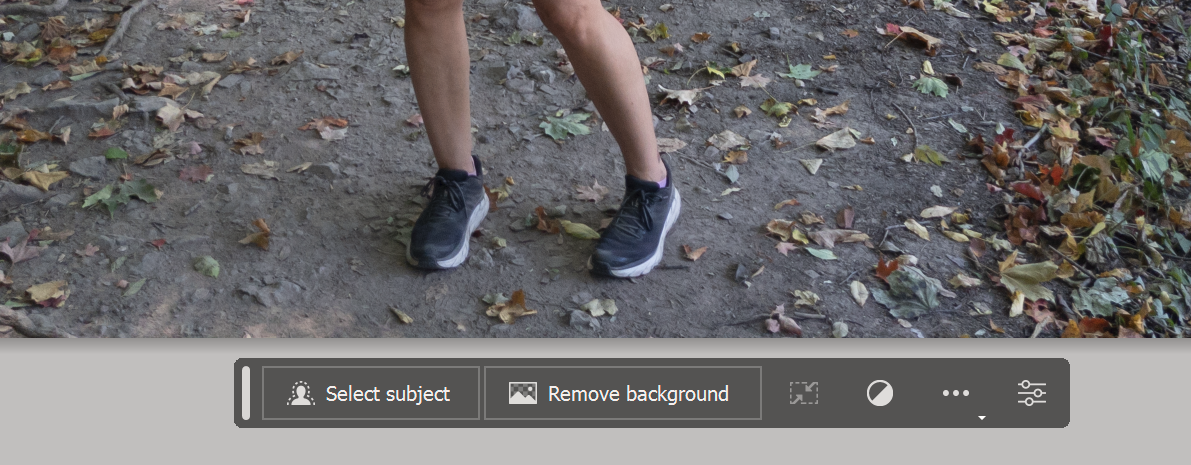 (Credit: Adobe/PCMag)
(Credit: Adobe/PCMag)The Contextual Task Bar is a small toolbar that floats along the bottom portion of the image you're working on and lets you perform relevant actions. The feature took me by surprise because it looks like a plug-in. But it's helpful for opening relevant side panel entries. If you don't like it cluttering your workspace, removing it from view is an option in the three-dot overflow menu on the right. New capabilities in the latest update include Fill, Flip, Rotate, and Stroke.
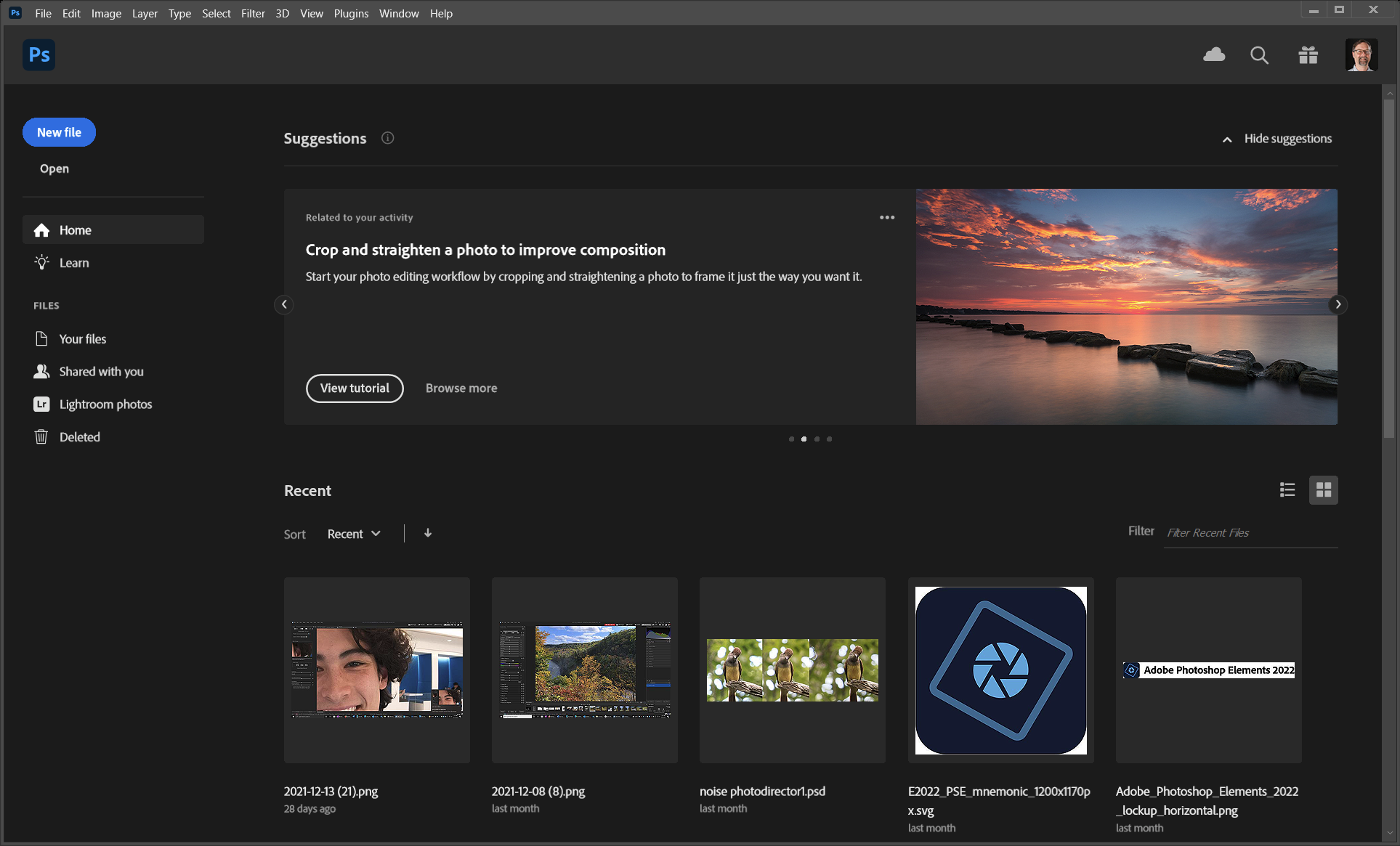 (Credit: Adobe/PCMag)
(Credit: Adobe/PCMag)On the start screen, you see New File, Open, Home, and Learn, as well as file locations for photos you've uploaded through Lightroom and shared Cloud Documents. The Home icon takes you to suggested tutorials and thumbnails of your recent document. When you choose New File, you get a tabbed dialog with templates such as Instant Film Mockups, Photo Collage Layouts, and Textured Geometric Masks. Category filters across the top let you restrict the proposed templates to Art & Illustration, Film & Video, Mobile, Photo, Print, and Web. If you copy an image onto the clipboard, the software gives you the option to open a new image with its exact dimensions.
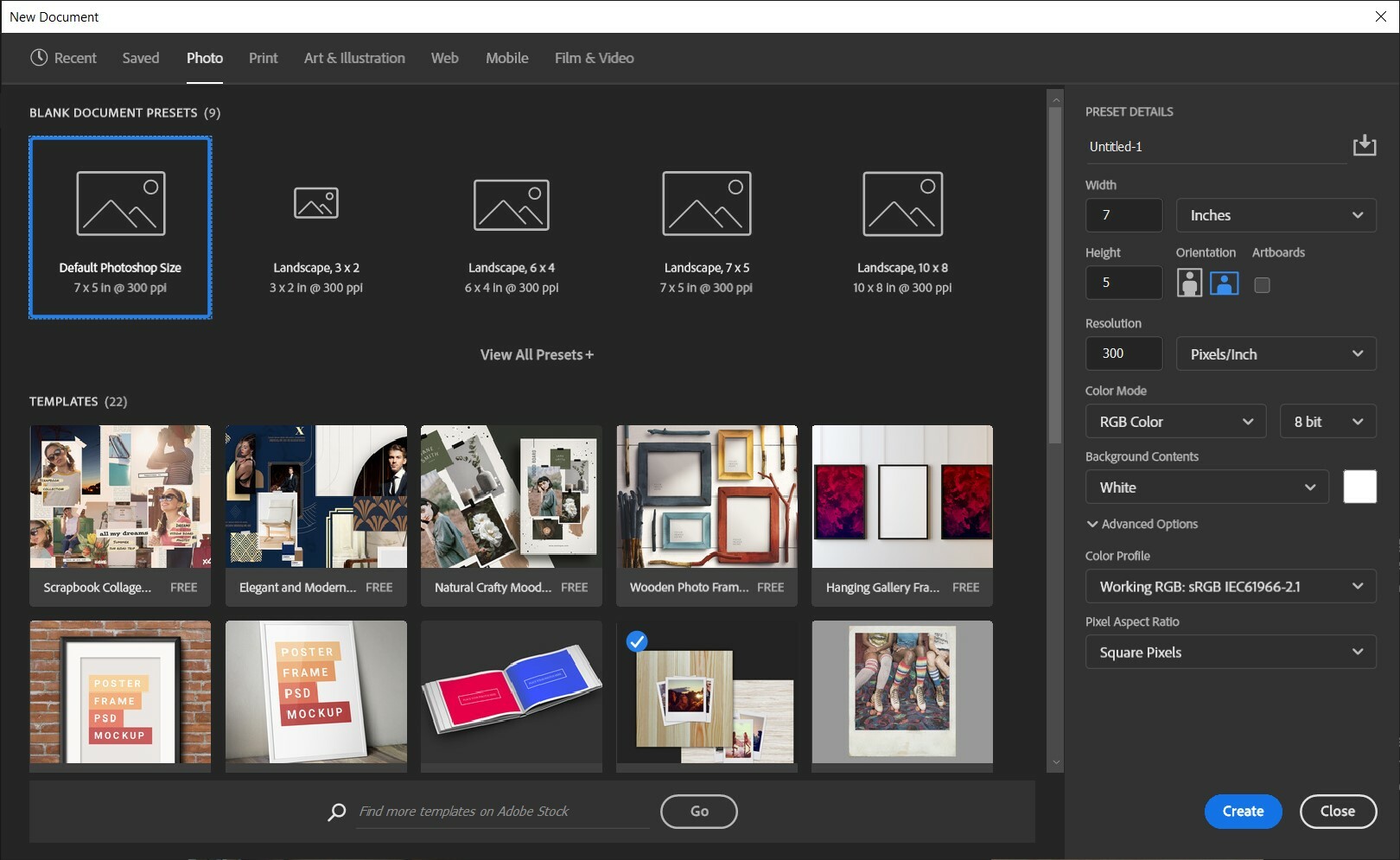 (Credit: Adobe/PCMag)
(Credit: Adobe/PCMag)You can pick from thumbnails of your recent files and access presets and libraries from the start page. The page shows personalized tutorial content at the bottom. You can switch back to the legacy starting experience if you prefer, but I find that the start page makes it much easier to get to things I'm interested in, such as recent projects.
The helpful, ever-present Search icon at the top right lets you find Adobe Stock images, program functions, tutorials, or your images. If you already have a file open when you click the Search button, the resulting dialog becomes a detached Discover window that presents command shortcuts and help. The panel's Home icon shows tutorial suggestions, What’s New items, the user guide, and more resources. An always-available search function in a complex desktop application is always welcome.
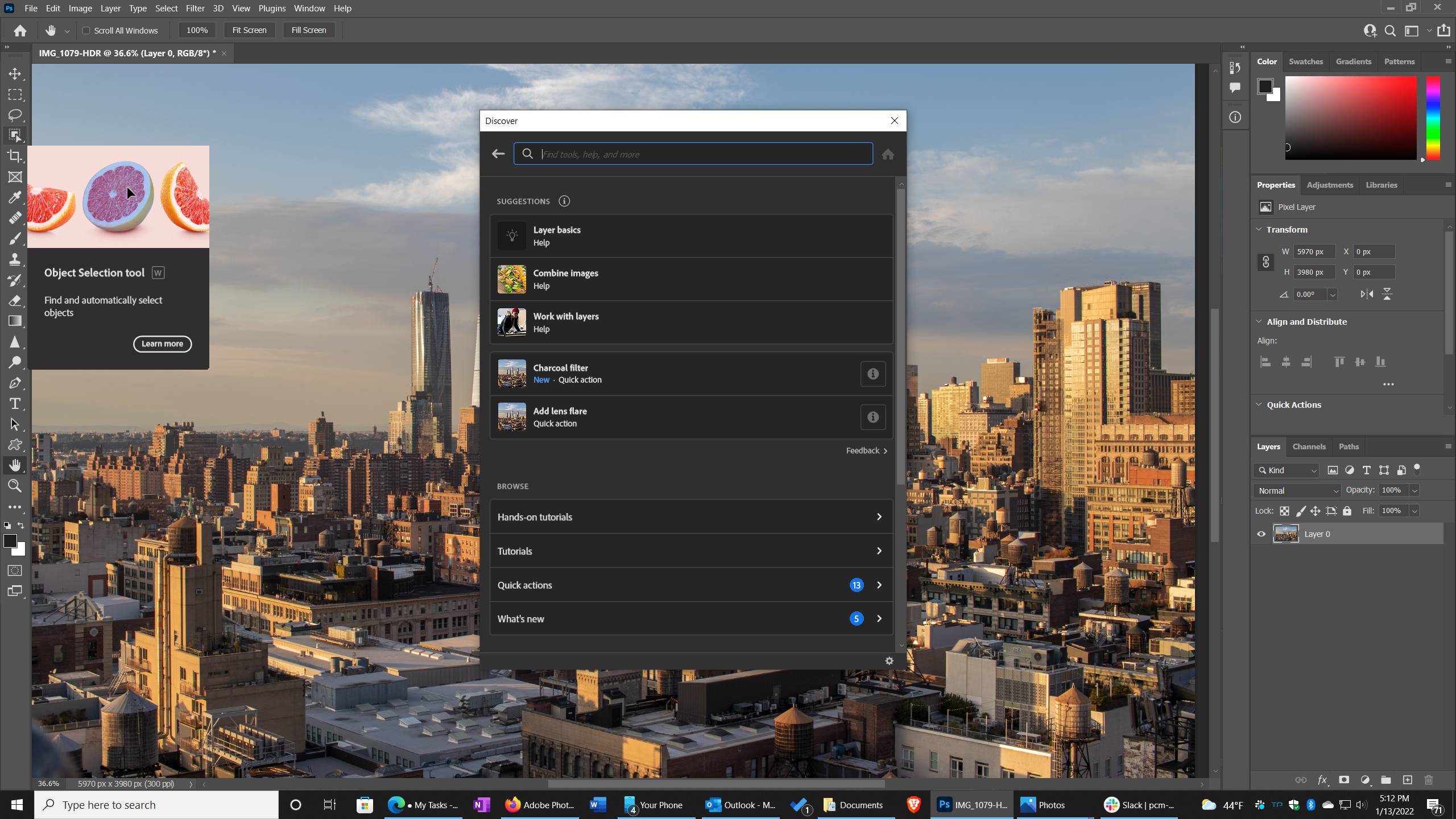 (Credit: Adobe/PCMag)
(Credit: Adobe/PCMag)The interface also adapts to the purpose at hand. Take the Select and Mask workspace, for instance; it's available whenever you have a selection tool active. It shows only the tools useful during selection, such as Brush, Hand, Lasso, Refine Edge, and Zoom, along with the relevant Properties panel. The interface's color themes have a pleasing, context-sensitive consistency, too. If you set the window borders to be light gray, all dialogs will likewise be gray.
 (Credit: Adobe/PCMag)
(Credit: Adobe/PCMag)Useful Selection Tools
 (Credit: Adobe/PCMag)
(Credit: Adobe/PCMag)One of the main uses of Photoshop is to select objects and people in photos. It's also one of the top pain points. Photoshop still includes the venerable Lasso, Magic Wand, and Marquee, as well as the Object and Quick selection tools (with their cool Subject Select checkbox). Of note are the Selection Brush, Select on Hover option, and the Select and Mask workspace, which includes a Refine Edge option.
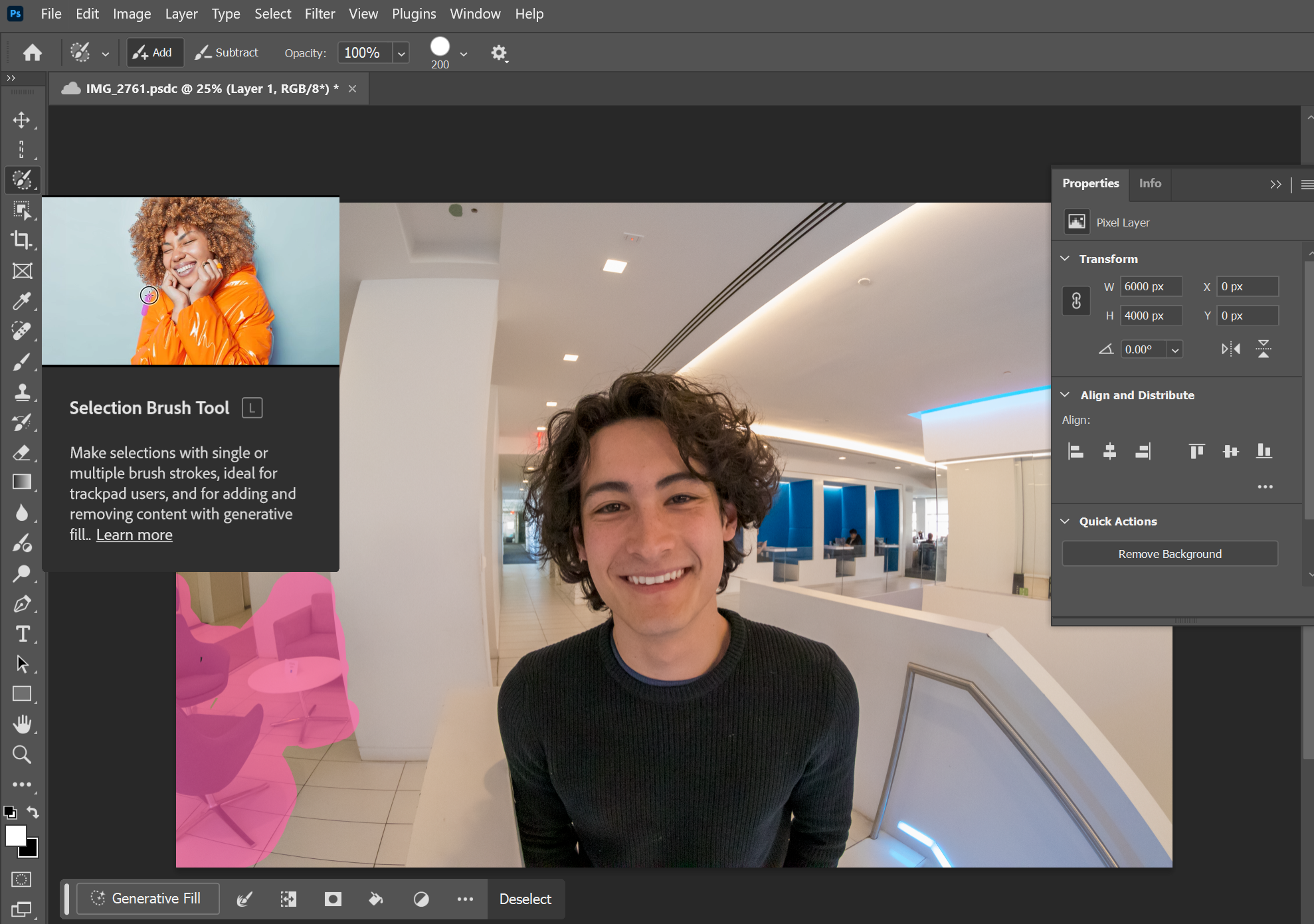 (Credit: Adobe/PCMag)
(Credit: Adobe/PCMag)Photoshop's recent Selection Brush works similarly to a regular brush for painting, complete with opacity and hardness settings. Once you select something with it, the Contextual Task Bar gives more choices, including Feather Selection, Select Border, Smooth Selection, and Transform Selection. You can also open the Select and Mask interface for more refinements. A handy use for this new tool is to use Generative Fill based on your selection. I was able to remove the furniture on the left side of the photo above.
Select on Hover gives you a nifty way to create masks. It uses Adobe’s Sensei AI technology to detect all objects in the image. As you hover over each, Photoshop highlights it for selection. Select on Hover works with the Object Selection tool, which is in the same tool button as Magic Wand and Quick Selection. Press and hold it to use it. Check the Object Finder checkbox in the options bar and the Auto Show Overlay in the gear icon's settings. Then, move the cursor around the image to see the software shade various objects. You can tap the Show All Objects button (the square containing different-size rectangles) to show all the automatically selected objects. A related menu option, Layer > Mask All Objects, creates separate masks for all the objects Photoshop detects in a layer.
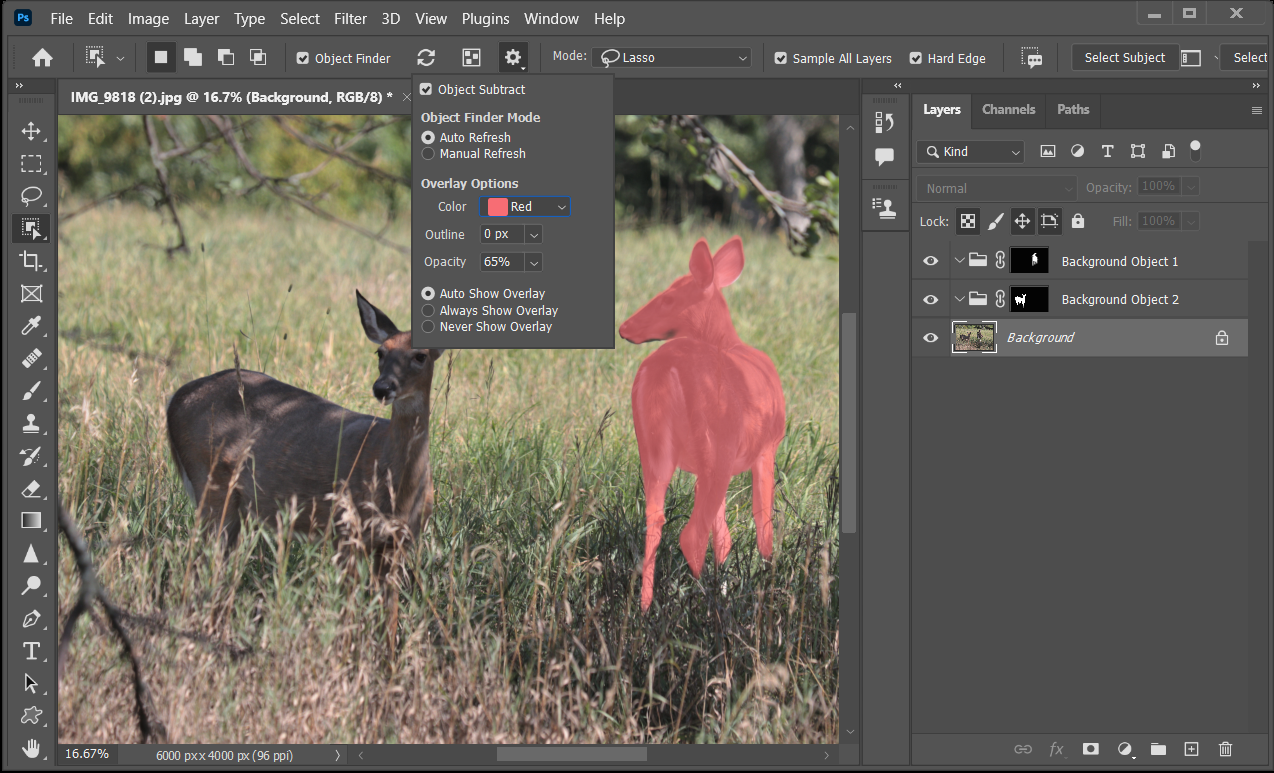 (Credit: Adobe/PCMag)
(Credit: Adobe/PCMag)Select Subject uses AI to automatically determine and select the main object in an image. When active, a Select Subject button appears in the options bar across the top of the program windows. In testing, it did a remarkable job of selecting people when the background was relatively uniform. More complex backgrounds caused some issues, however.
Adobe continues to improve the selection of complex hair with Subject Select. Once again, the tool worked mostly well but hasn’t yet reached the holy grail of one-and-done hair selection. It failed to select some hair in my test shot and picked up some lines in the background. Even pressing the Refine Hair button and cloud processing options didn't improve the situation much, as you can see below, leaving some of my test subject's hair clearly visible. You can use the Select and Mask workspace tools to fix these issues.
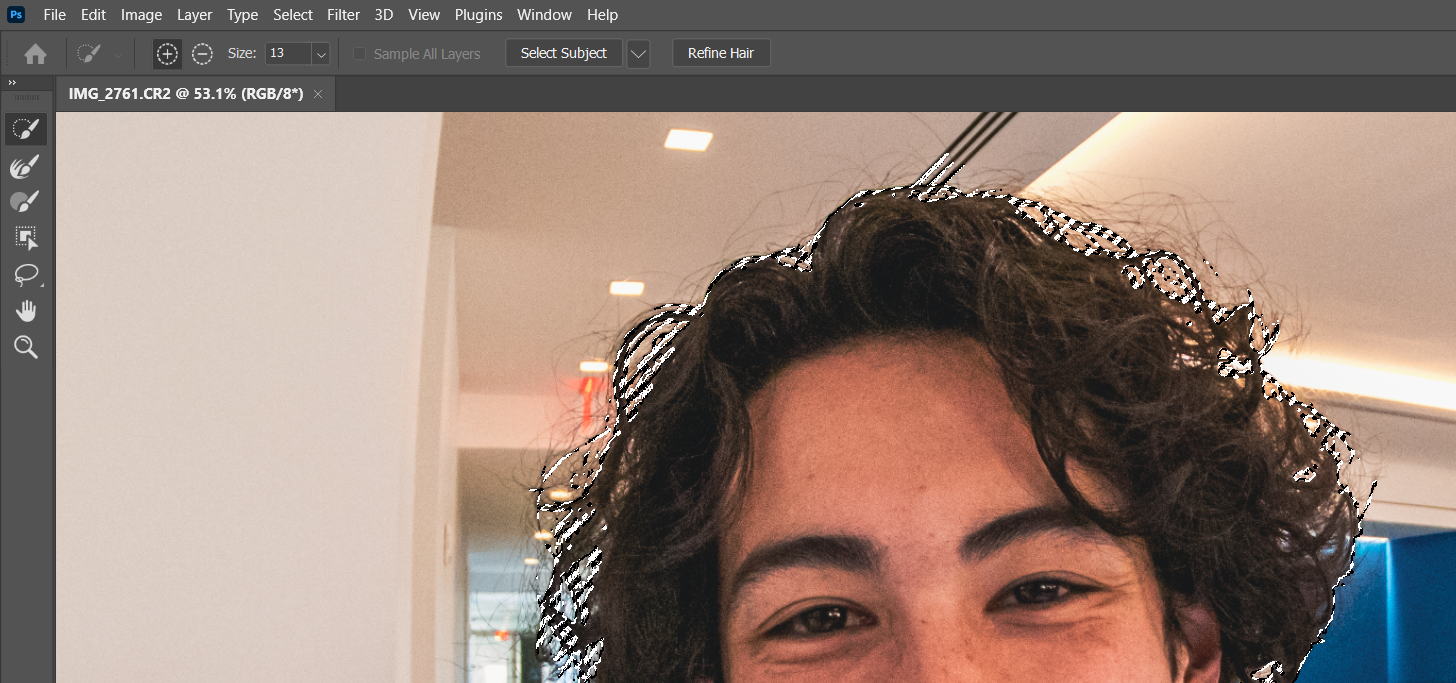 (Credit: Adobe/PCMag)
(Credit: Adobe/PCMag)Remove Tool
While not merely a selection tool, the Remove Tool does indeed work via selection capabilities. Photoshop has long let you select and remove an object from your photos, but this is a one-step tool. My first attempts resulted in a smeared portion of the person I was trying to remove; you have to paint over the entire object rather than inside it. Overshooting the edges is fine. The tool did an impressive job of filling in the background, as you can see below.
 (Credit: Adobe/PCMag)
(Credit: Adobe/PCMag)If you want to change or remove the background in your photo, you can use Photoshop's Remove Background quick action from the Contextual Task Bar or by typing "remove background" in the persistent search box. Since the automatic selection might be less than perfect, you could use the Select and Mask tool to get it just right.
Distraction Removal
You’ve already been able to remove distractions from images in Photoshop, but now the program can find them for you automatically.
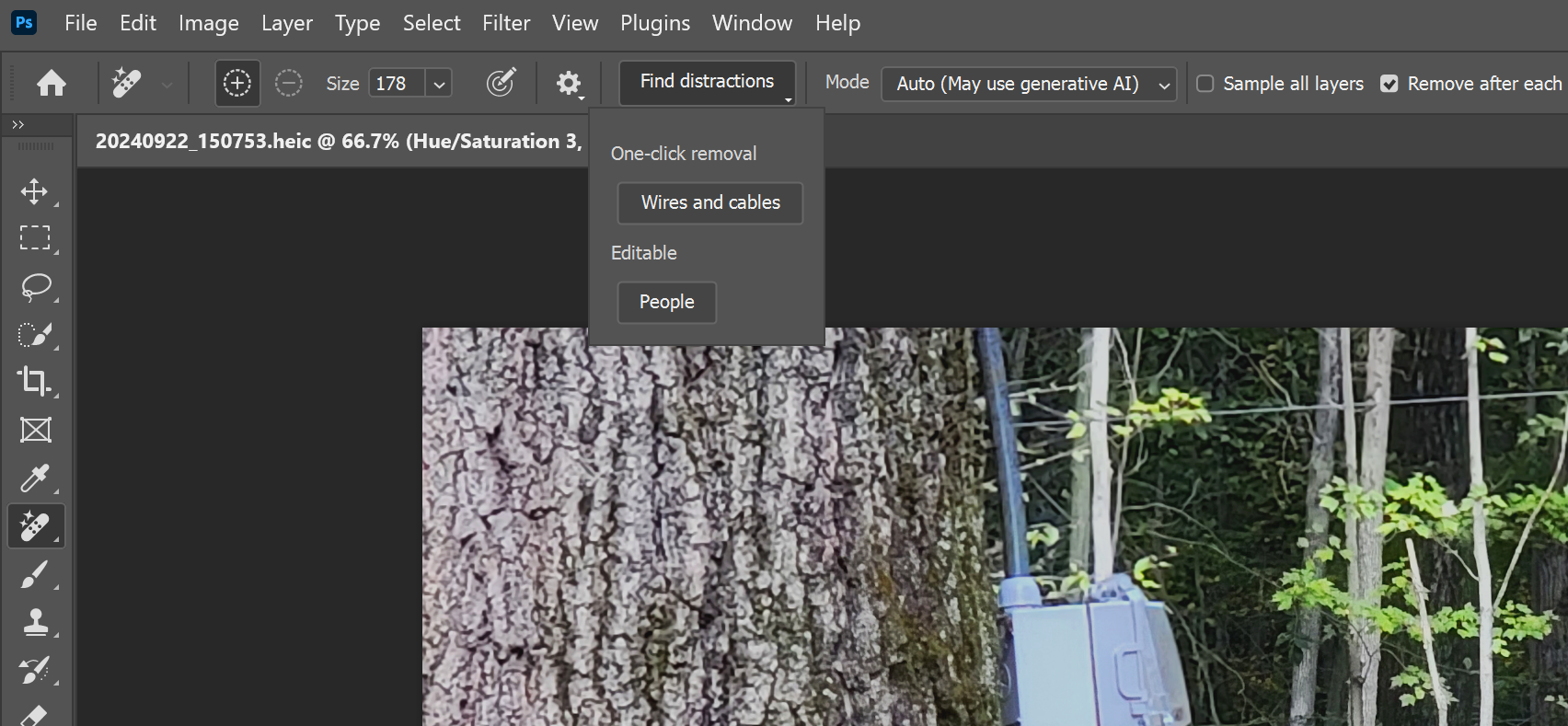 (Credit: Adobe/PCMag)
(Credit: Adobe/PCMag)The Remove tool has a drop-down menu that identifies wires and cables or people in the image that take attention away from your subject. To be fair, Skylum Luminar deserves credit for adding a nearly identical (and very effective) AI feature two years ago in its Objects Removal section called Remove?Powerlines.
When I first tried the Find Distractions option, I got a “target layer is unsupported” message and the software told me to create a new layer. After creating a new layer, I got an “image is transparent” error message. Finally, simply selecting the background layer got me the perfect results. Interestingly, the feature doesn’t create a new layer for masking out the wires, so it’s destructive editing. In testing, it works better than the Luminar tool, even handling wires that go over complex backgrounds.
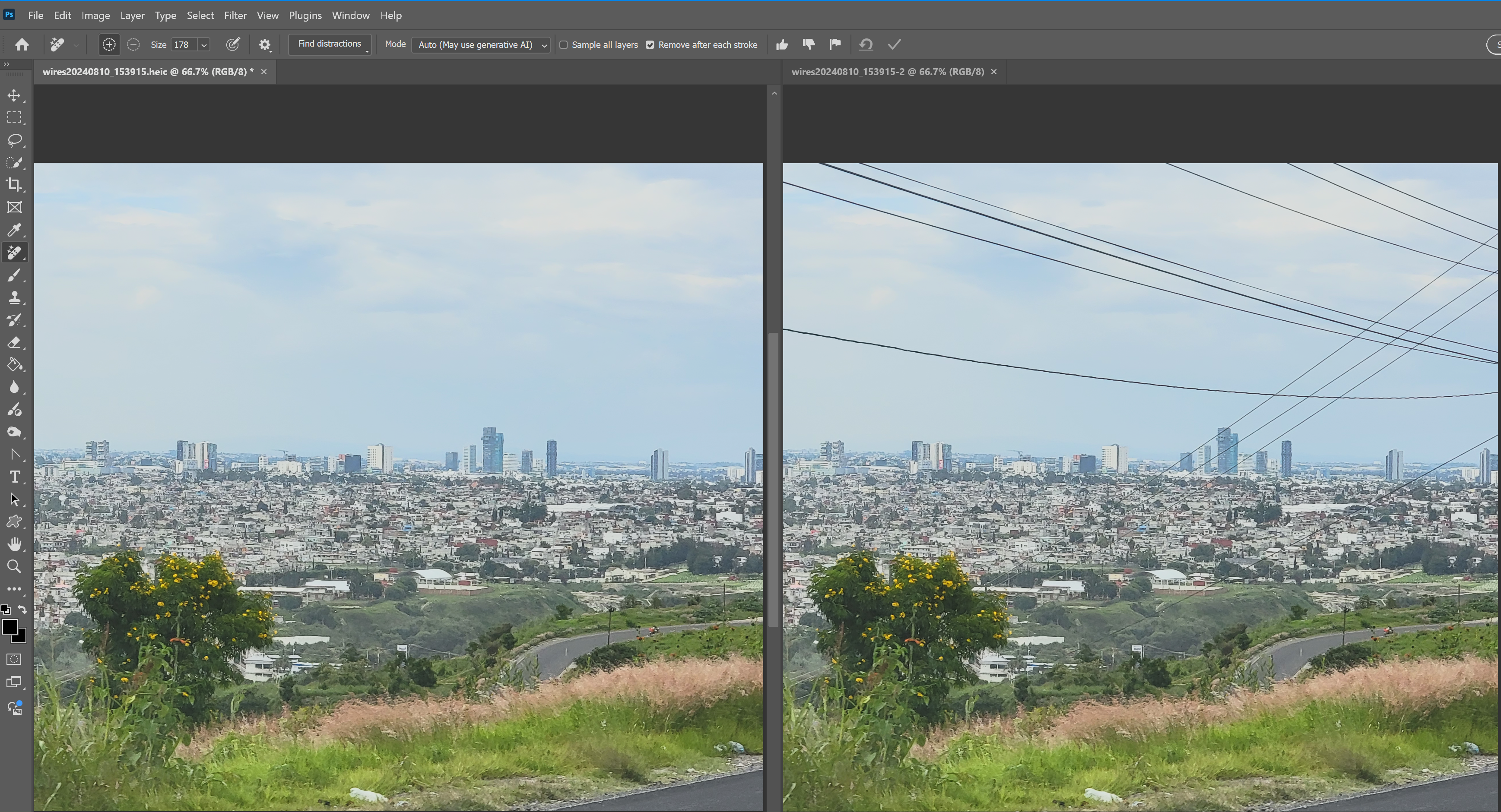 (Credit: Adobe/PCMag)
(Credit: Adobe/PCMag)When you want to remove extraneous humans from a photo, Photoshop highlights all the people it finds in pink, and you get to use the minus brush to undo removal for those you want to keep. My test of this was tougher, with several people to remove. The result looks good at first glance, but you can see that faraway trees appear in place of a fence where I removed the man in the pink shirt (the original is in the smaller insert).
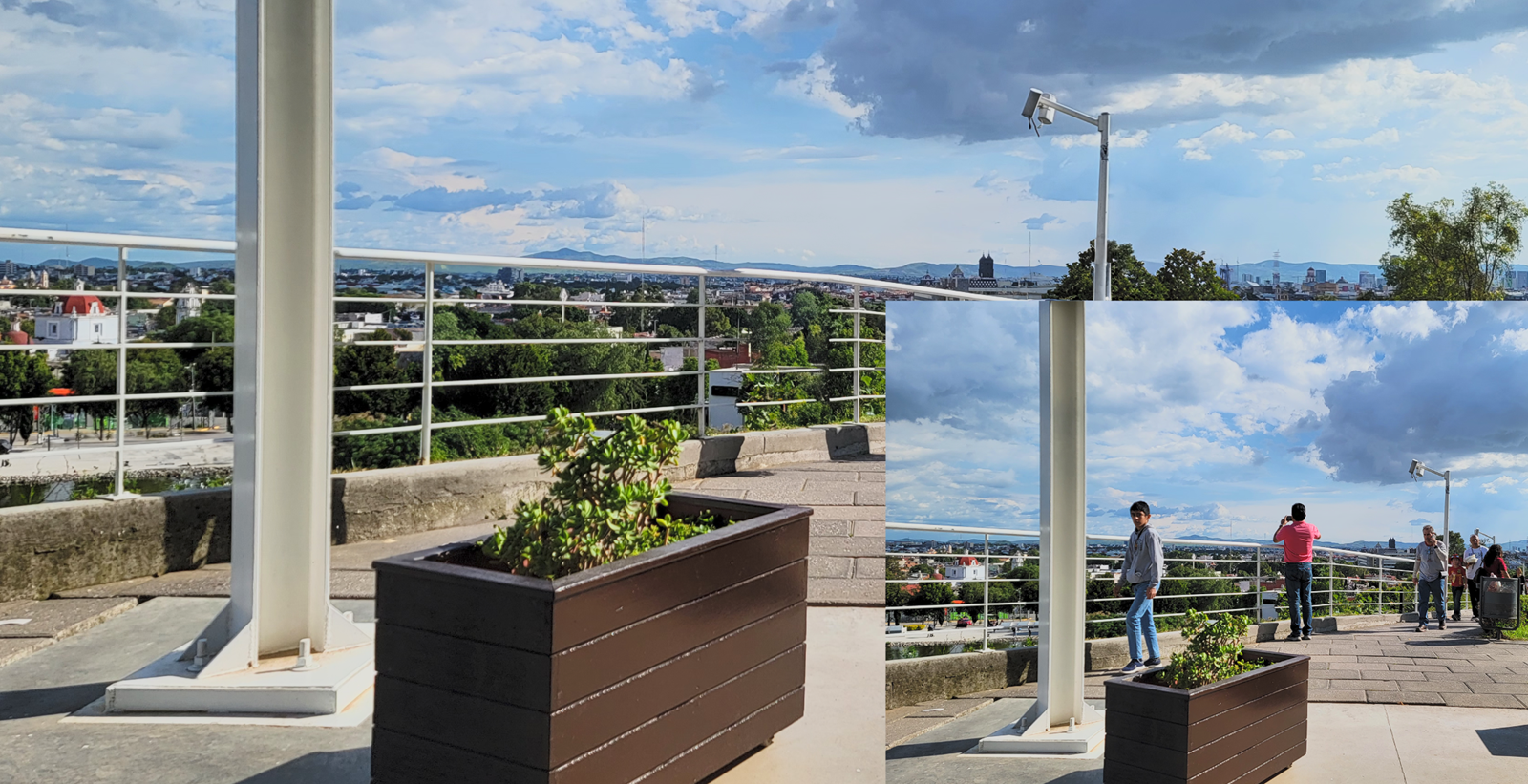 (Credit: Adobe/PCMag)
(Credit: Adobe/PCMag)A Growing Set of Firefly Generative AI Features
Photoshop now has four Firefly generative AI tools: Generate Background, Generate Image, Generative Expand, and Generative Fill. Helpful built-in tutorials teach you how to use each one. Before you do anything, you must agree to Adobe's user guidelines. Basically, it says you can't use the tools to train other AIs, to create porn, other offensive material, or deepfakes, or to violate trademarks. You can use the AI creations for commercial purposes safely. By default, they include Content Credentials (see the Deepfakes section below).
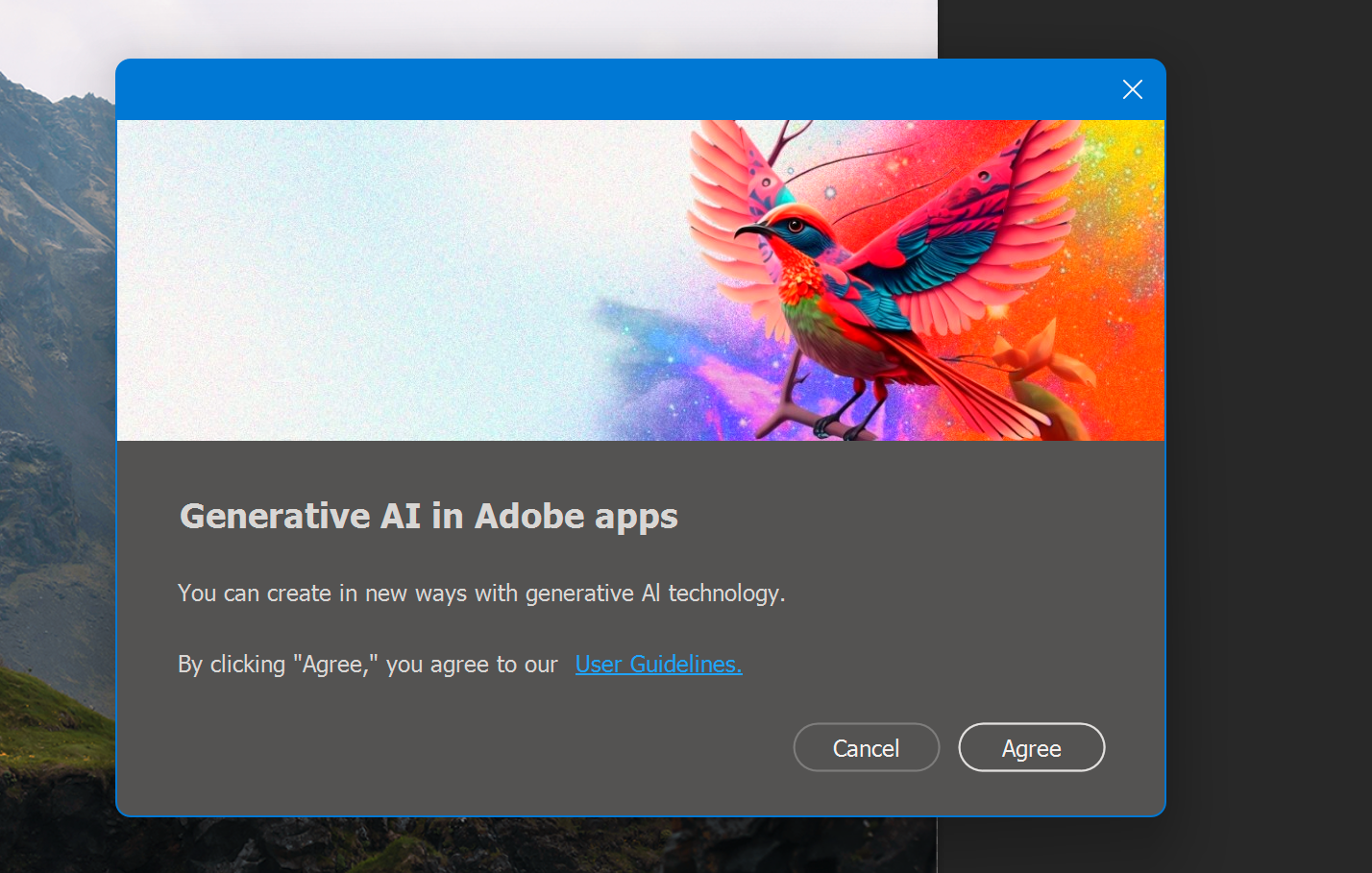 (Credit: Adobe/PCMag)
(Credit: Adobe/PCMag)To get started with Generative Fill and Generative Expand, you select an area in the image using your choice of selection tool. One of the cool things about Adobe's generative AI is that the text prompt is right there in the image you're working with, thanks to the context-sensitive Contextual Task Bar. You can also start creating an image with Generate Image from scratch from that tool, as well.
Generative Fill
Generative Fill creates completely new objects in your image in an area you select. You can also use it to transform objects. I started by selecting a chunk of the road, shown below.
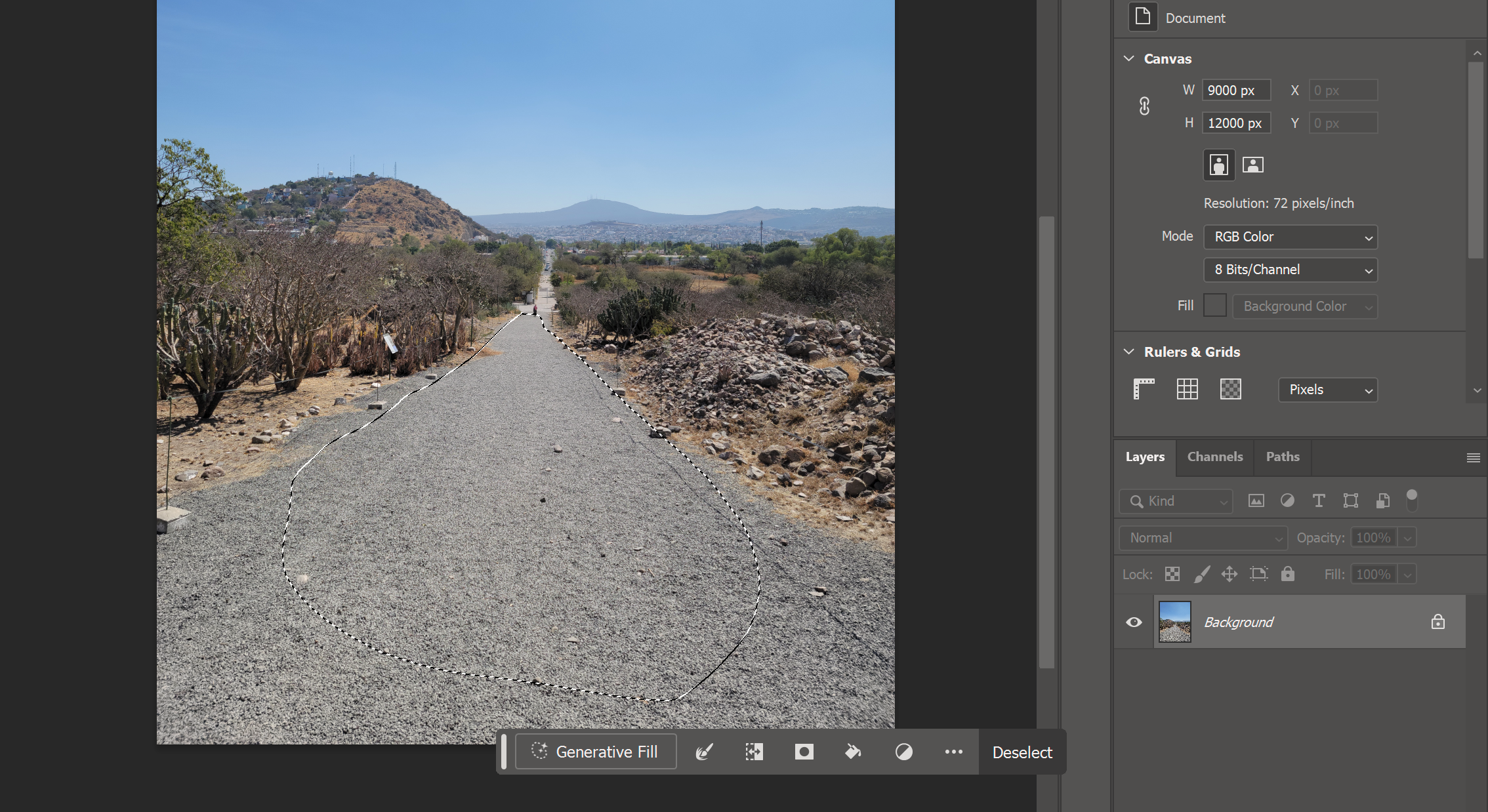 (Credit: Adobe/PCMag)
(Credit: Adobe/PCMag)When I typed 'herd of purple elk with wings" in the text box and pressed the Generate button, the tool somehow considered this offensive and wouldn't generate an image.
 (Credit: Adobe/PCMag)
(Credit: Adobe/PCMag)After several similar results (apparently, the word elk is somehow offensive), I tried "herd of purple lifelike deer galloping." After a few seconds, I got the image below, in which the deer don't seem lifelike at all. Note the alternate choices in the Properties panel at the right. Clicking on any of those replaces the creation in the main image.
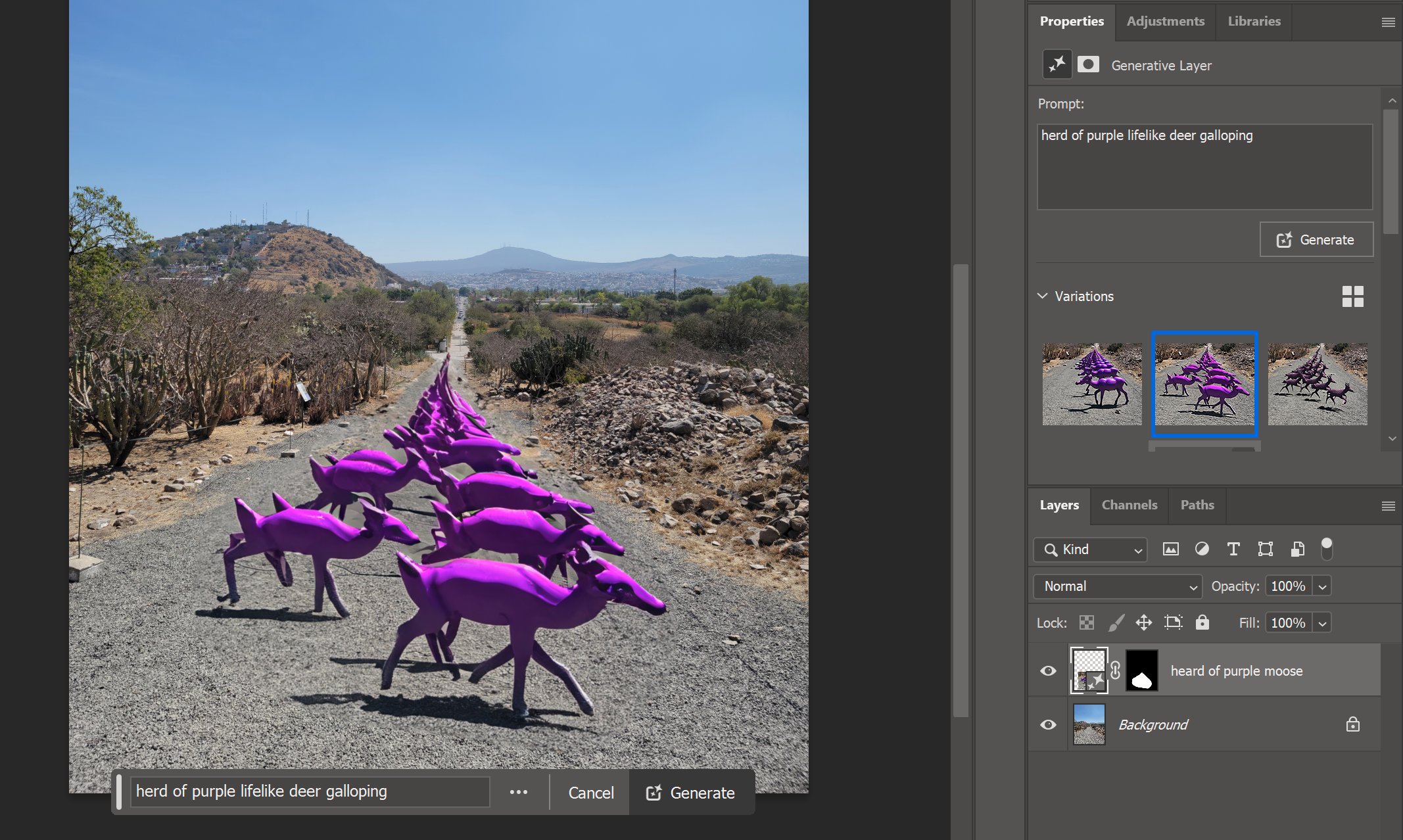 (Credit: Adobe/PCMag)
(Credit: Adobe/PCMag)After the recent update, my results were a little better, though the deer still looked plastic:
 (Credit: Adobe/PCMag)
(Credit: Adobe/PCMag)At one point, I even got an error message saying compositing preferences were set to CPU because of an error. After several unconvincing results with deer and moose, I got an OK result with "a herd of orange rhinos running," shown below.
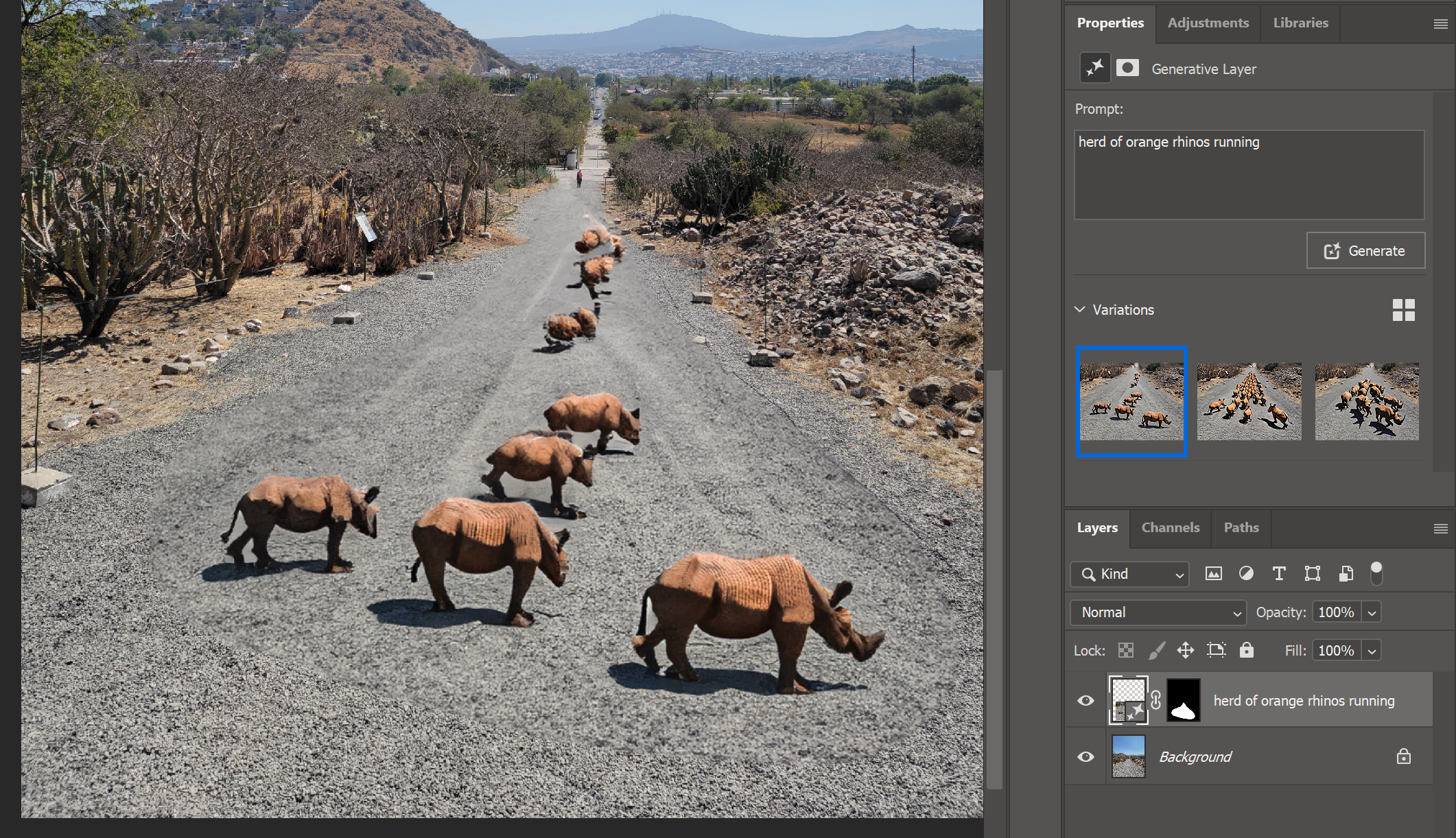 (Credit: Adobe/PCMag)
(Credit: Adobe/PCMag)You can use Enhance Detail in your Generative Fill results for sharper details.
Generative Expand
Imaging software that lets you expand photo scenes has been around for several years, starting with AntiCrop way back in 2012. It required that your image had consistent textures in the background. Photoshop itself produced a similar capability in its Crop tool, as I discuss below. The AI-powered Generative Expand doesn't require any consistency in the image to extend it.
The Generative Expand button appears on the Contextual Task Bar if you use the Crop tool and pull its edges out beyond the image's original borders.
 (Credit: Adobe/PCMag)
(Credit: Adobe/PCMag)With this tool, you also get a text box asking what you'd like to use to fill the frame. I said "white mountains" and got the below result:
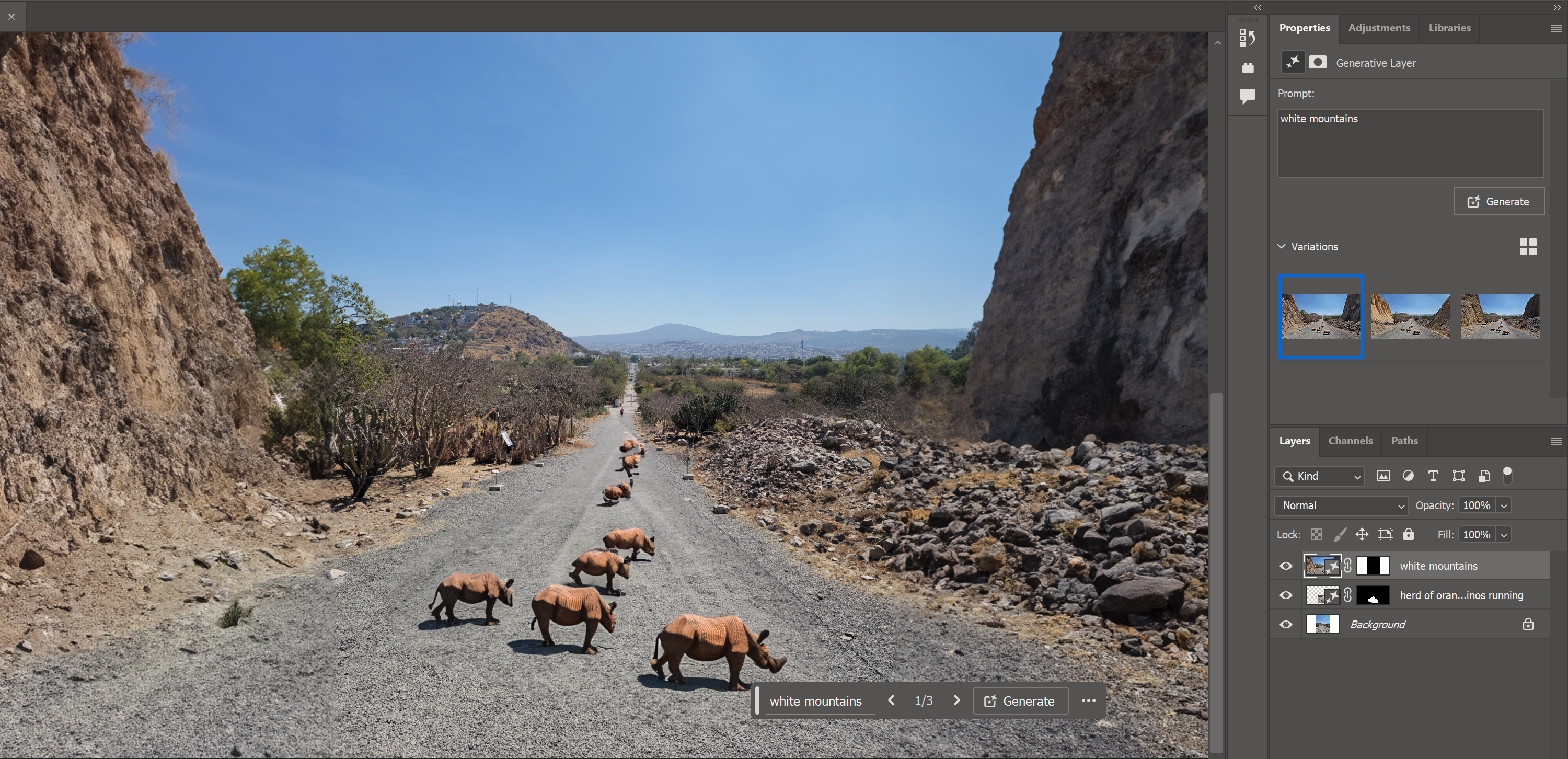 (Credit: Adobe/PCMag)
(Credit: Adobe/PCMag)Yes, the mountains aren't really white, but they do blend nicely with the existing image. If you just want the borders filled in similarly to the existing image, you don't have to enter anything in the text prompt box at all. It works convincingly, as you can see below:
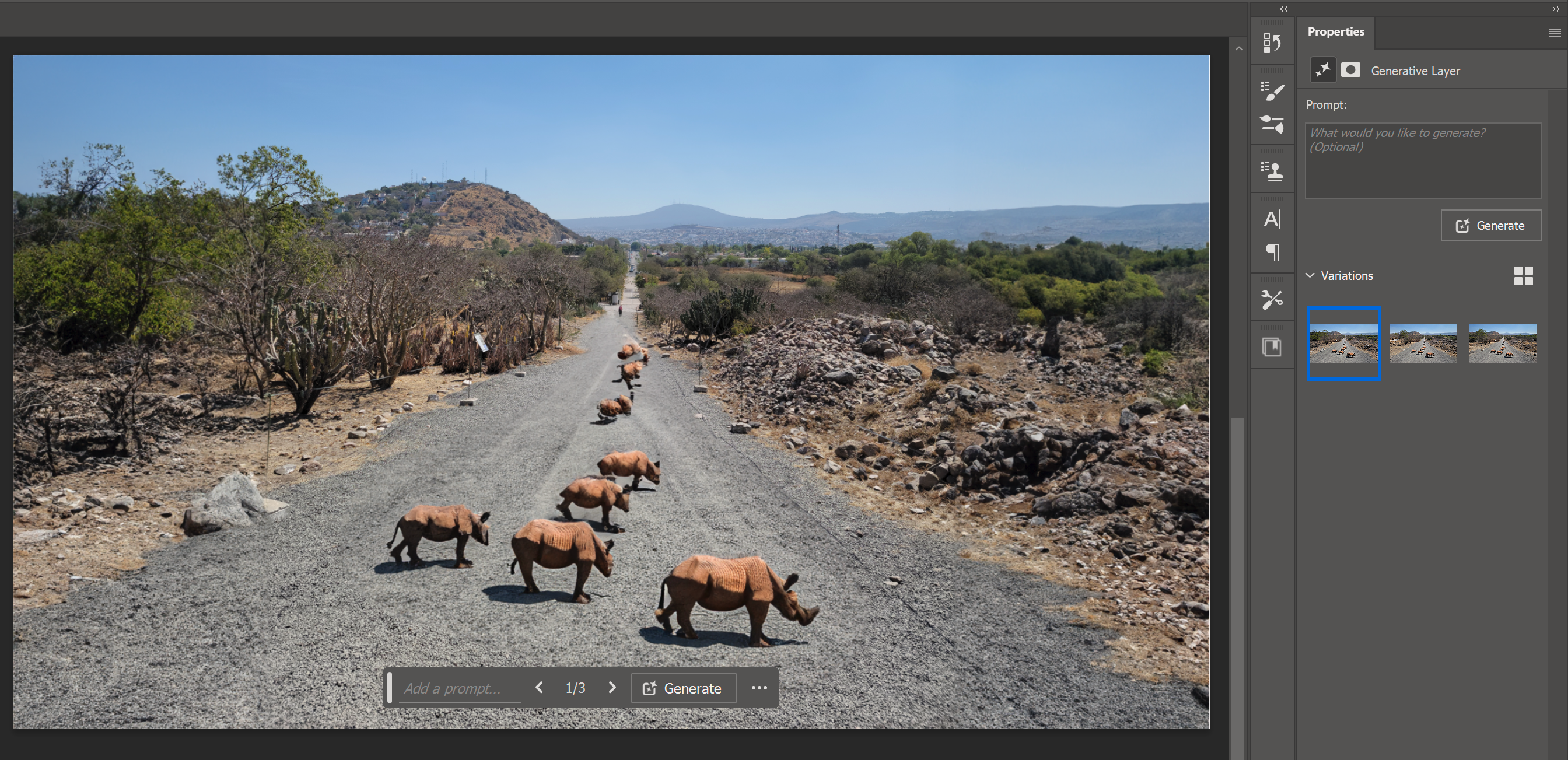 (Credit: Adobe/PCMag)
(Credit: Adobe/PCMag)I should note that, for the first time in perhaps over a year, these tools caused Photoshop to crash a couple of times for me. I suspect there may be an issue with my particular graphics card.
Generate Image
Photoshop now lets you generate a completely new image using Firefly rather than requiring you to modify an existing one as you do with the tools above. You get to it from Edit > Generate Image. You can upload your own image for reference, and the tool gives you suggestions if you're completely blocked.
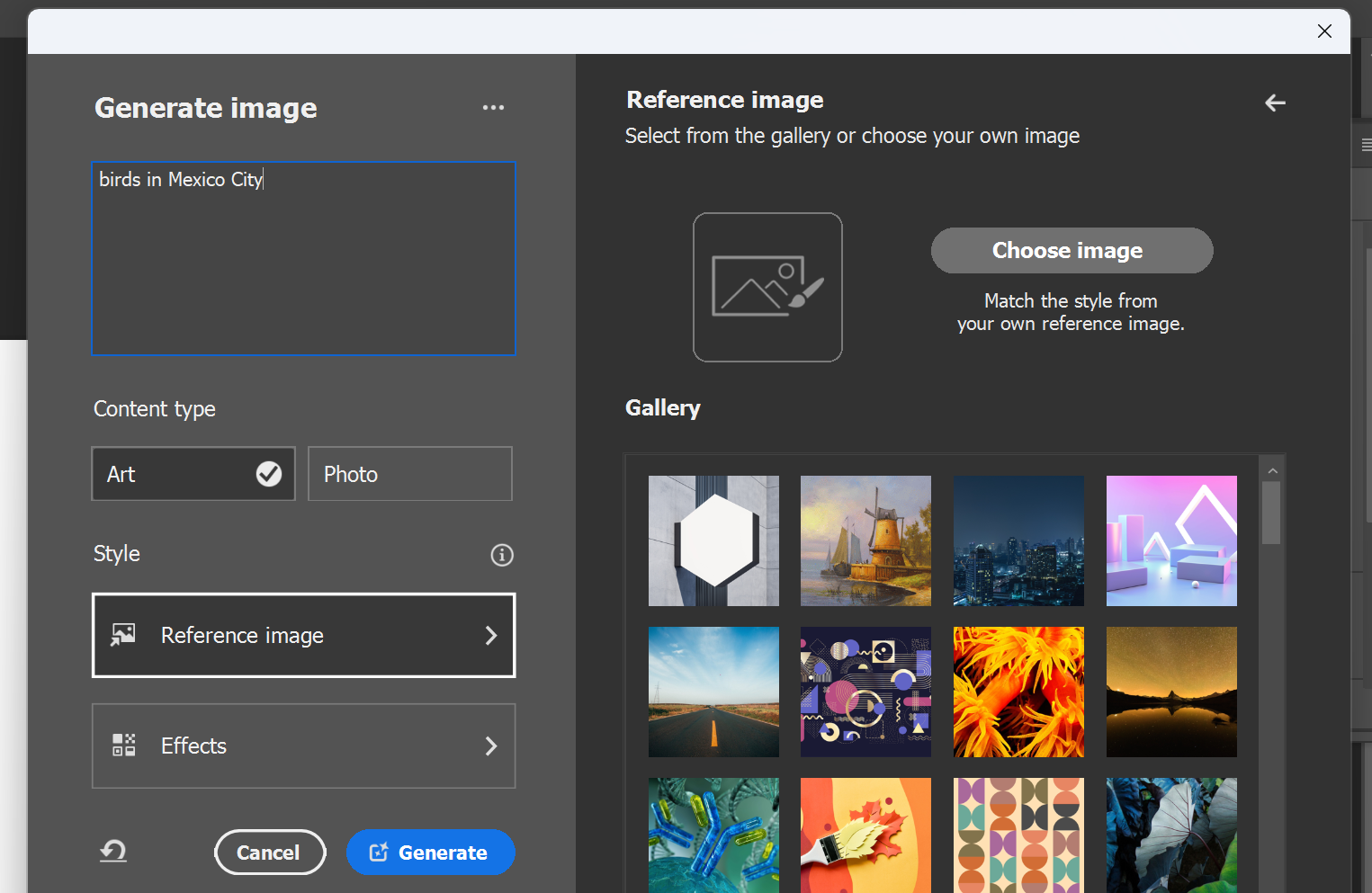 (Credit: Adobe/PCMag)
(Credit: Adobe/PCMag)You can choose between Art and Photo, and the generated image appears right in your canvas, with alternative options on the side. It’s important to choose Art if you want art and Photo if you want a photorealistic result.
Here's what it came up with for the prompt, "birds in Mexico City." The first result included fictitious, nonexistent AI birds, which I didn't like. But some of the versions had appeal:
 (Credit: Adobe/PCMag)
(Credit: Adobe/PCMag)I also wanted to test how well these tools imitate the style of a famous artist. I uploaded a Rembrandt painting and asked for a group of friends drinking Coke in the same style.
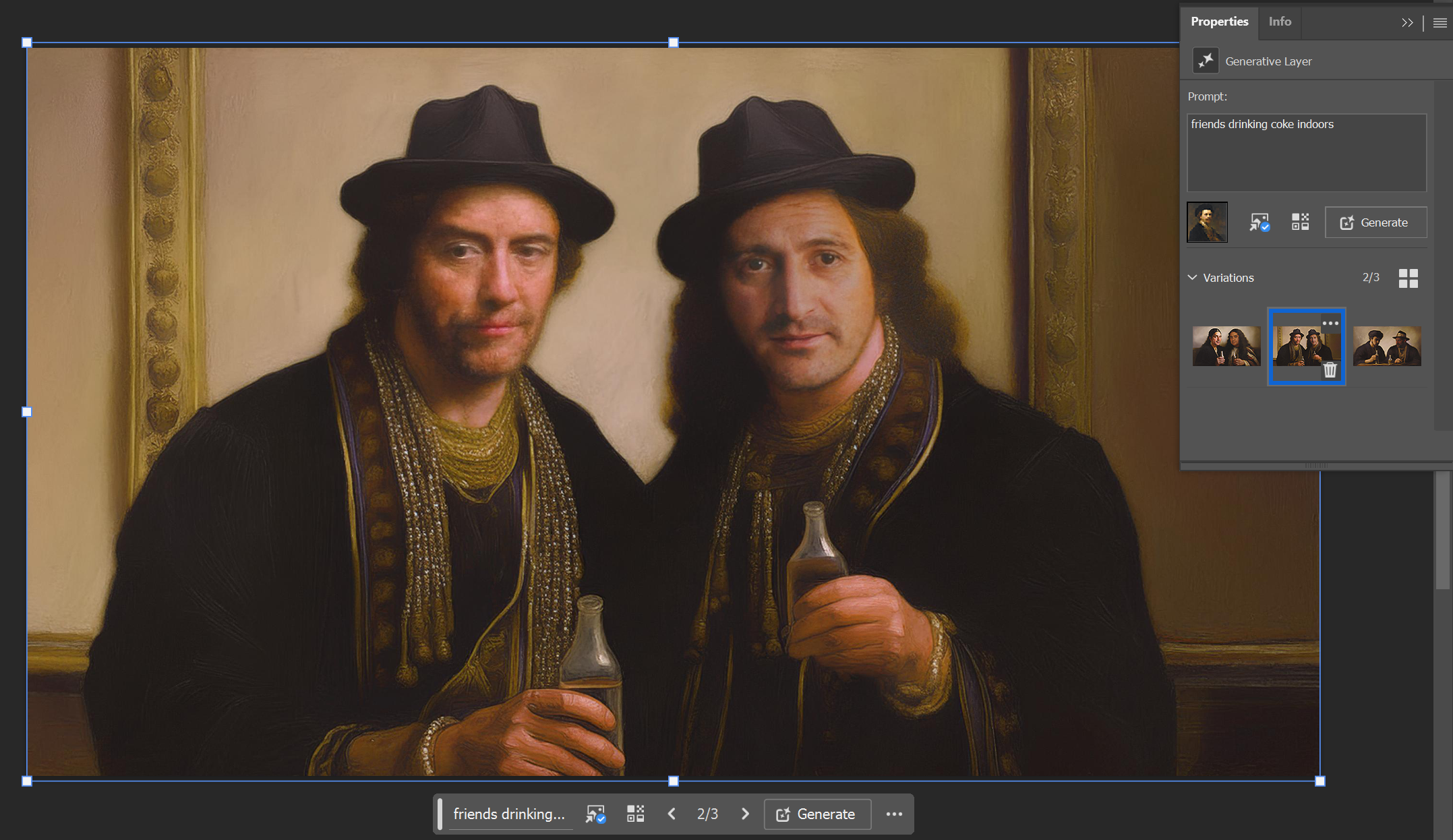 (Credit: Adobe/PCMag)
(Credit: Adobe/PCMag)The result is better than what I got when testing the beta a few months ago, but I still find OpenArt.ai's creations more convincing. Oddly, the two friends in Photoshop's generated image are in different styles and textures in all three choices. Though Adobe claims improvements in image generation in version 26, I found the same issues testing the newer version.
Generate Background
The final new generative AI tool in Photoshop is Generate Background, which appears in the contextual toolbar after you use Remove Background.
 (Credit: Adobe/PCMag)
(Credit: Adobe/PCMag)My text prompt for the background was “mountain scene in spring with birds.” After a try that resulted in birds with no wings and wings with no birds, when I specified “hawks,” the result was a little better (though there’s nothing to indicate spring, and the hawks aren’t naturally soaring or realistically proportioned).
 (Credit: Adobe/PCMag)
(Credit: Adobe/PCMag)Innovative Neural Filters
Among Photoshop's most exciting recent features are neural filters, which let you automatically change a portrait subject’s age, gaze, and mood. Neural here is short for neural network, a subset of AI machine learning. The tools take advantage of Generative adversarial networks, which, in essence, try to trick the AI algorithm with incorrect (i.e., adversarial) data. Most of the effects require a download, and they're not small. The Landscape Mixer was more than 380MB. Others, like Smart Portrait, do their processing in Adobe's cloud. Photoshop is good about telling you where processing happens for the filters. Be aware that even with graphics hardware acceleration, some of these effects took up to a half minute to complete on my test PC.
Some of the most interesting filters are still in beta: Color Transfer, Depth Blur, Harmonization, Landscape Mixer, and Photo Restoration. Of the 12 tools at the time of writing, Colorize, Makeup Transfer, JPEG Artifacts Removal, Skin Smoothing, Smart Portrait, Style Transfer, and Super Zoom are fully released and out of beta.
A Wait List tab shows tools not yet available: Noise Reduction, Portrait Generator, Water Long Exposure, and Shadow Regenerator. That first one is still in the wait list section despite Adobe including automatic noise reduction in its companion Adobe Camera Raw utility (more on that below).
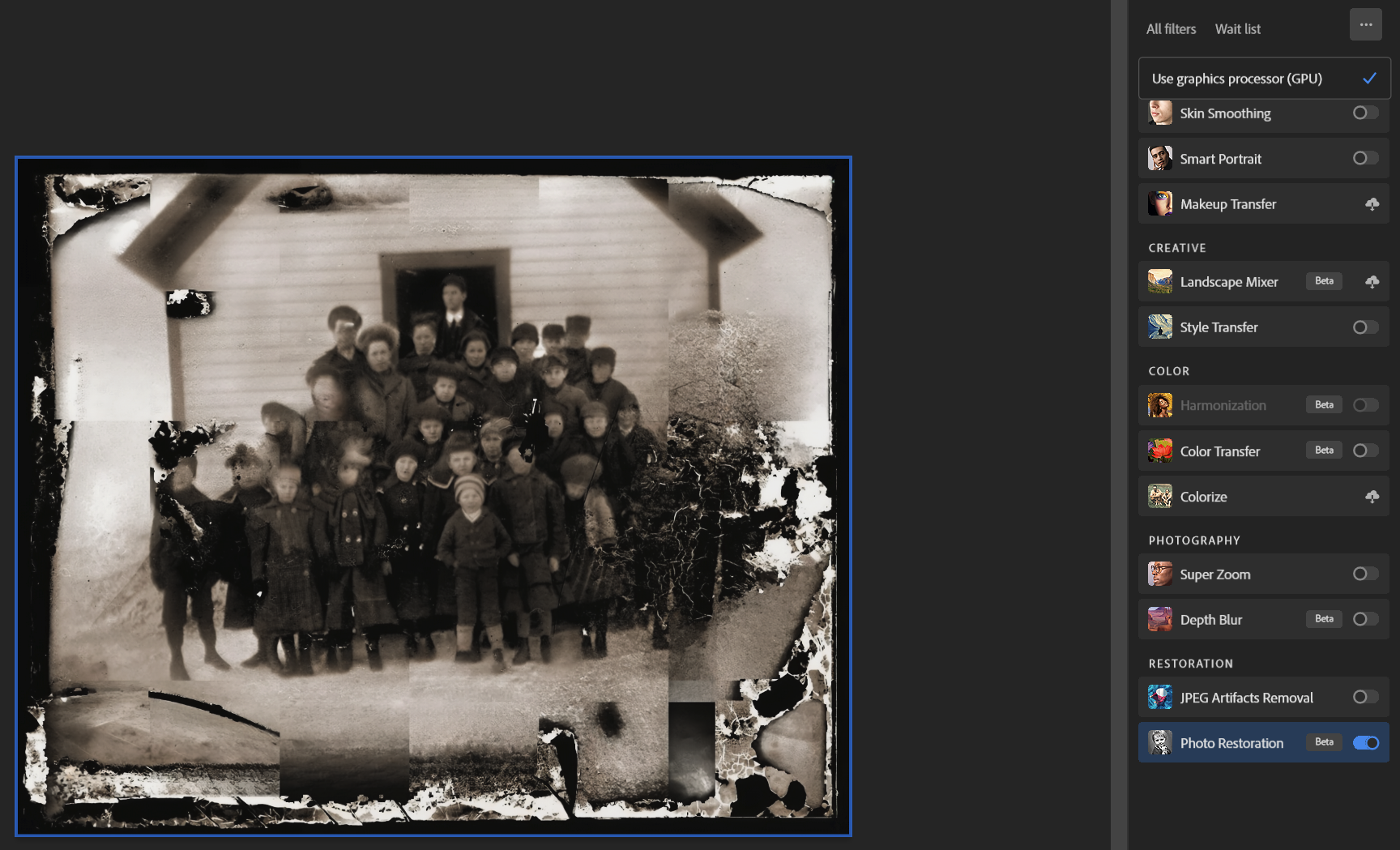 (Credit: Adobe/Flickr/William Creswell/PCMag)
(Credit: Adobe/Flickr/William Creswell/PCMag)Photo Restoration is a 769MB download. I tried this tool on an old public-domain photo from Flickr, perhaps an unfair test, given how damaged it is. Though the filter didn't perfectly restore the image (above), it did make impressive improvements. In another old photo with a couple of deep scratches (below), the filter worked better, if not perfectly.
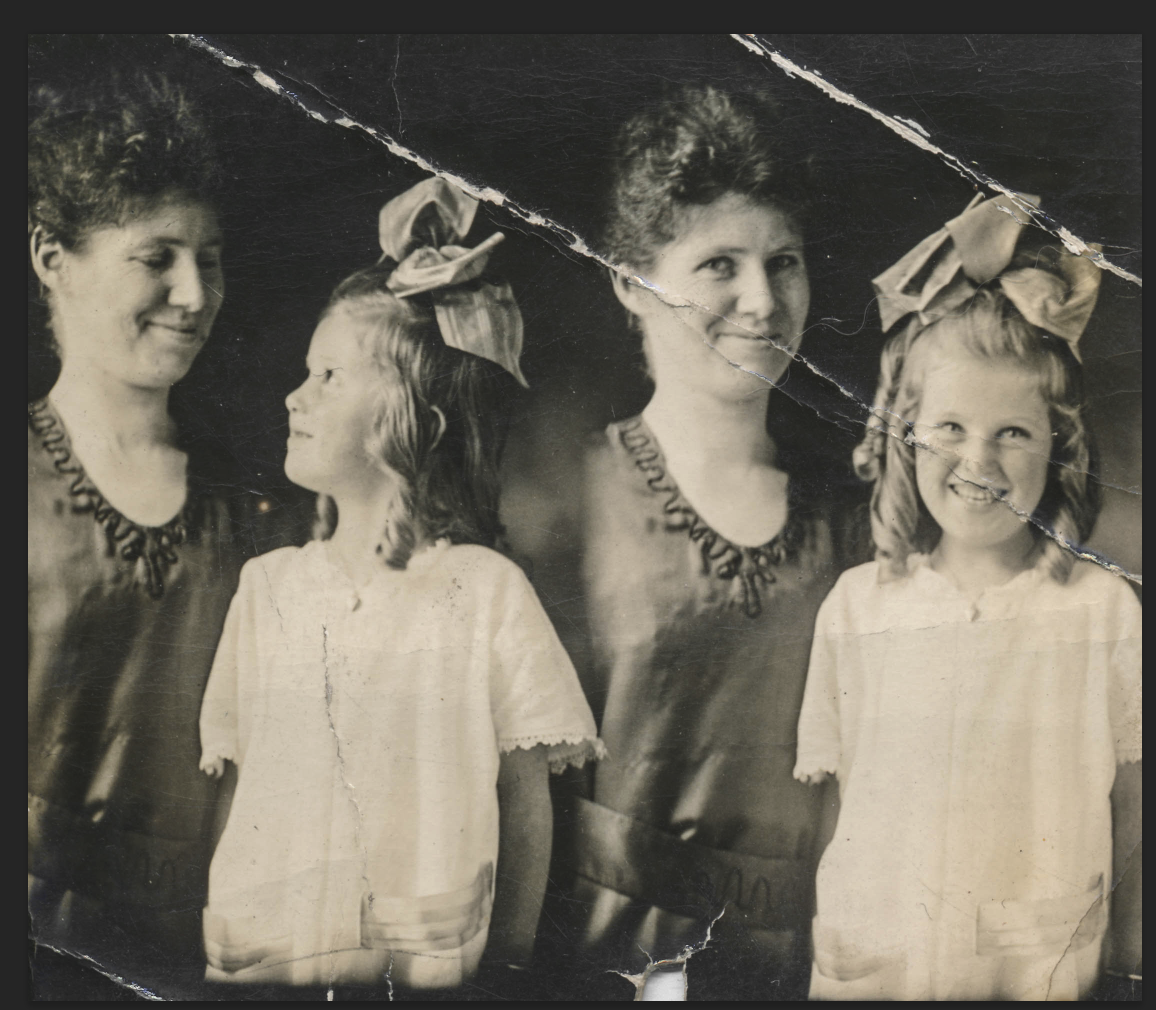 (Credit: Adobe/Flickr/simpleinsomnia/PCMag)
(Credit: Adobe/Flickr/simpleinsomnia/PCMag)Here is how it looks after I applied Photo Restoration, increasing the Scratch Reduction slider.
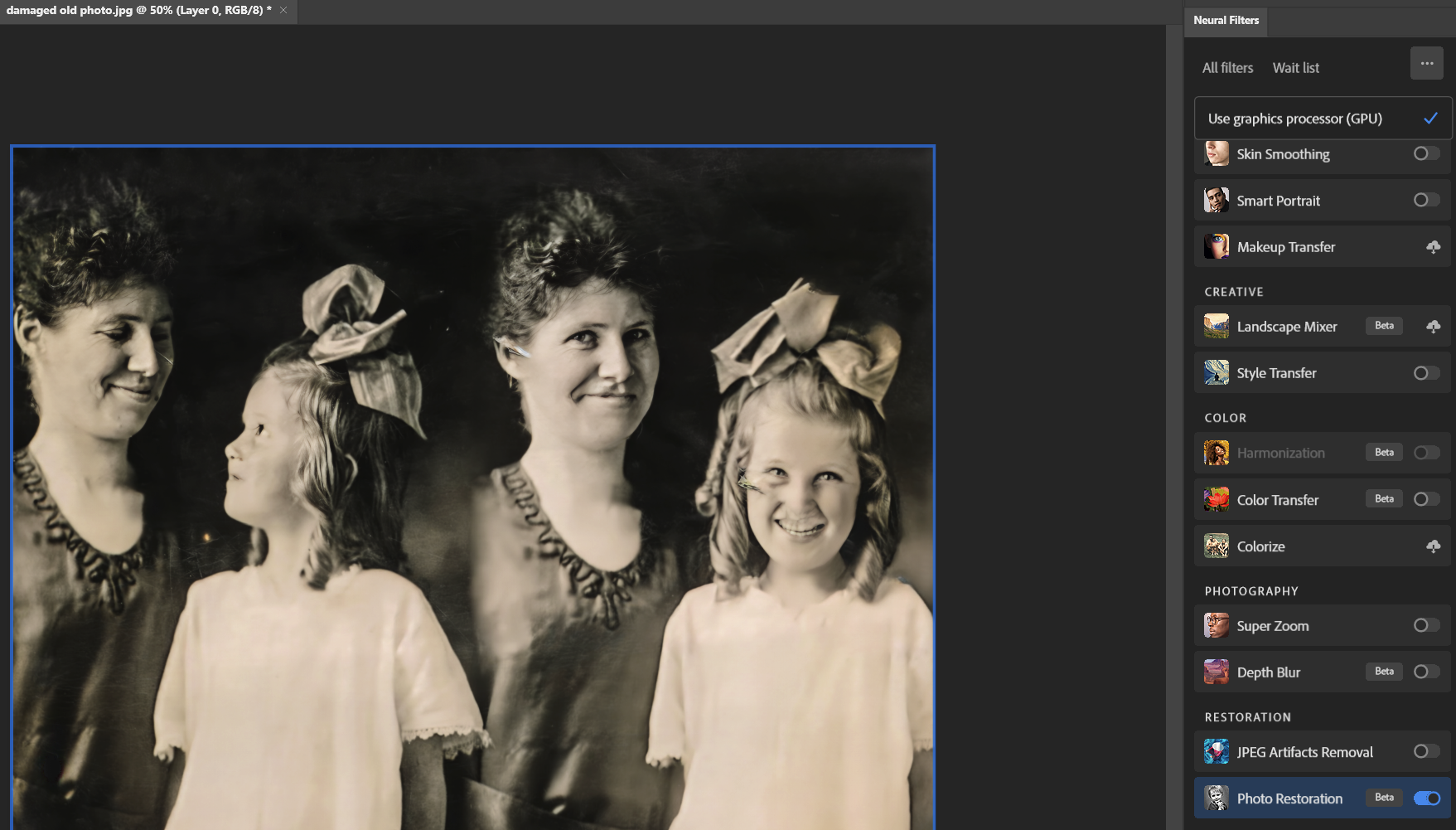 (Credit: Adobe/Flickr/simpleinsomnia/PCMag)
(Credit: Adobe/Flickr/simpleinsomnia/PCMag)You can still see remnants of the scratch on the girl's face and the woman's ear, but it's a definite improvement.
The Color Transfer filter (not to be confused with Style Transfer) lets you apply the colors and tones of one image to another.
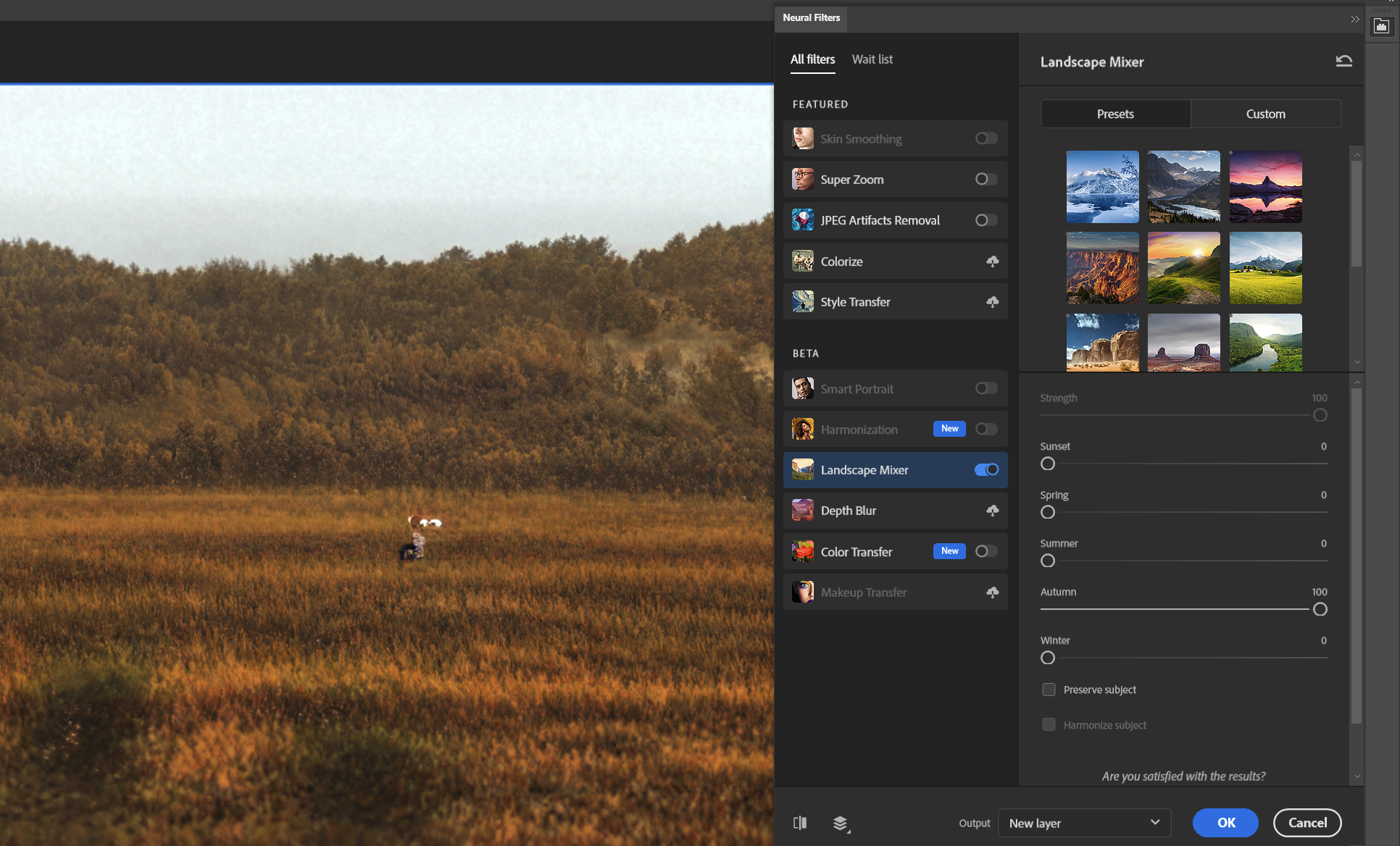 (Credit: Adobe/PCMag)
(Credit: Adobe/PCMag)The beta Landscape Mixer filters let you change a scene’s season from, say, summer to fall or make a midday scene look like you shot it at sunset. In testing, the Landscape Mixer did indeed give the foliage fall colors. However, it removed an egret that was in the original photo, so you're best using it on pure landscapes.
The face tools in Smart Portrait are more fun than practical, though they may be useful to portrait photographers in some limited cases. When I ramped up the Happiness slider on most pictures, the result was more like a forced smile than a natural one, though it can be effective if you don’t turn it up. There are also sliders for Anger and Surprise, which were surprisingly effective. The algorithm failed to de-age the neck on some subjects.
An interesting option is Retain Unique Details. If you uncheck this option, your subject approaches a Barbie doll appearance. One slider, Placement, can nudge the face selection box right or left, though it didn't do much in my test shots. If you use the Light Direction slider judiciously, it can work to good effect. The Gaze slider moves the eyes subtly, but the head direction tool wasn’t convincing in my test photos.
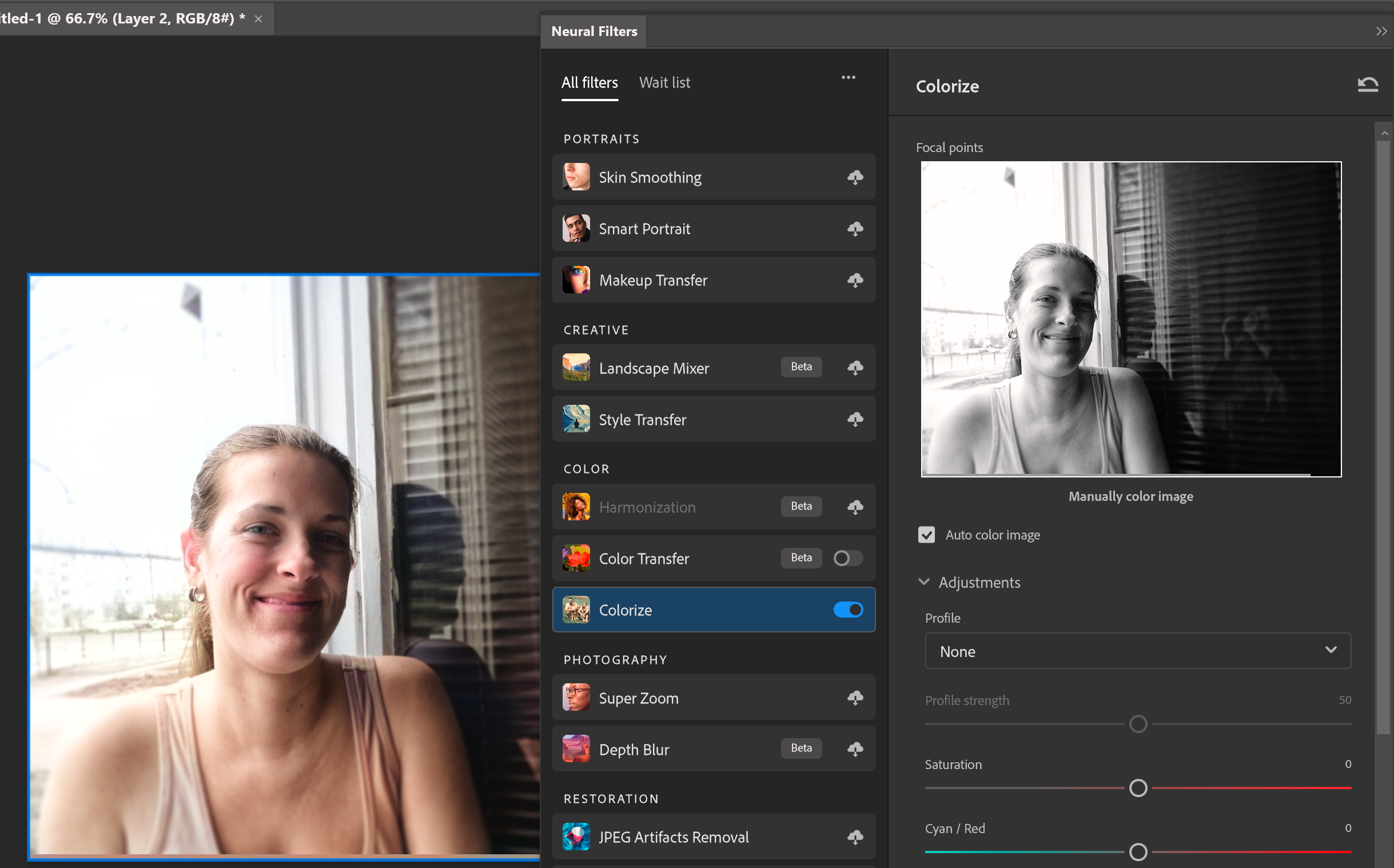 (Credit: Adobe/Flickr/Anno Málie/PCMag)
(Credit: Adobe/Flickr/Anno Málie/PCMag)The Colorize tool is impressive, as you can see from the above example of a slightly underexposed photo. On some very old high-contrast photos, the tool wasn't able to colorize, however. (Photoshop Elements got a Colorize tool earlier than Photoshop, and it works well.) The neural tools do have a before-and-after button, but I wish the software let you compare changes in a side-by-side view.
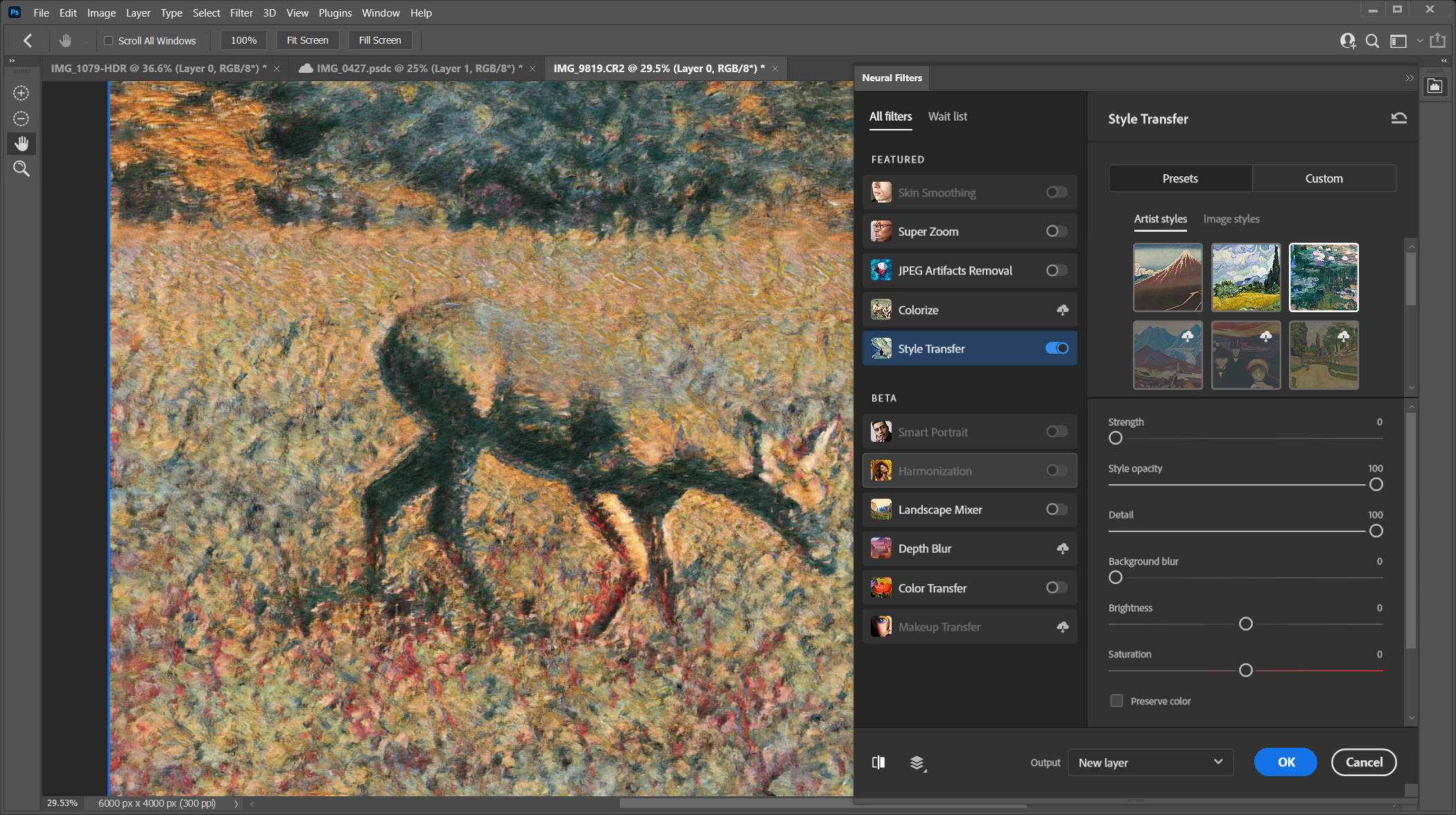 (Credit: Adobe/PCMag)
(Credit: Adobe/PCMag)The final neural filter worth mentioning has been available from competitors for a few years, notably in Cyberlink PhotoDirector. It’s the Style Transfer effect, which makes your photo look like the work of an artist such as Picasso or van Gogh. It’s a 176MB download at the time of testing. You get a good selection of looks, with more than 30 to choose from. You not only choose the strength of the effect but can also blur the background, change the brush size, focus on the subject, and preserve color. It’s a good implementation of this effect.
Excellent Tools for Photographers
Though it's now packed with drawing and font tools, Photoshop got its start as a photo editing and printing application. It remains the most powerful photo editing software today. Along with its completely photography-focused sibling, Lightroom, Photoshop has the most support for raw camera files and the most correction and effects. From removing or adding objects with content-aware tools to lens-profile-based geometry correction to histogram adjustments to stained-glass effect filters, Photoshop has it all. It's impossible to cover every feature here, but I take a closer look at a couple of the standout tools below.
Sky Replacement
For a while, Photoshop trailed software such as Skylum Luminar in handling skies in photos. Replacing a drab sky with a beautiful one used to be a many-step process involving manual masking and layers. Photoshop solves that problem with a Sky Replacement tool that is instant and awesome. You get many choices, ranging from pleasant to dazzling, and you can adjust the brightness, edge, position, and temperature of your chosen sky replacement.
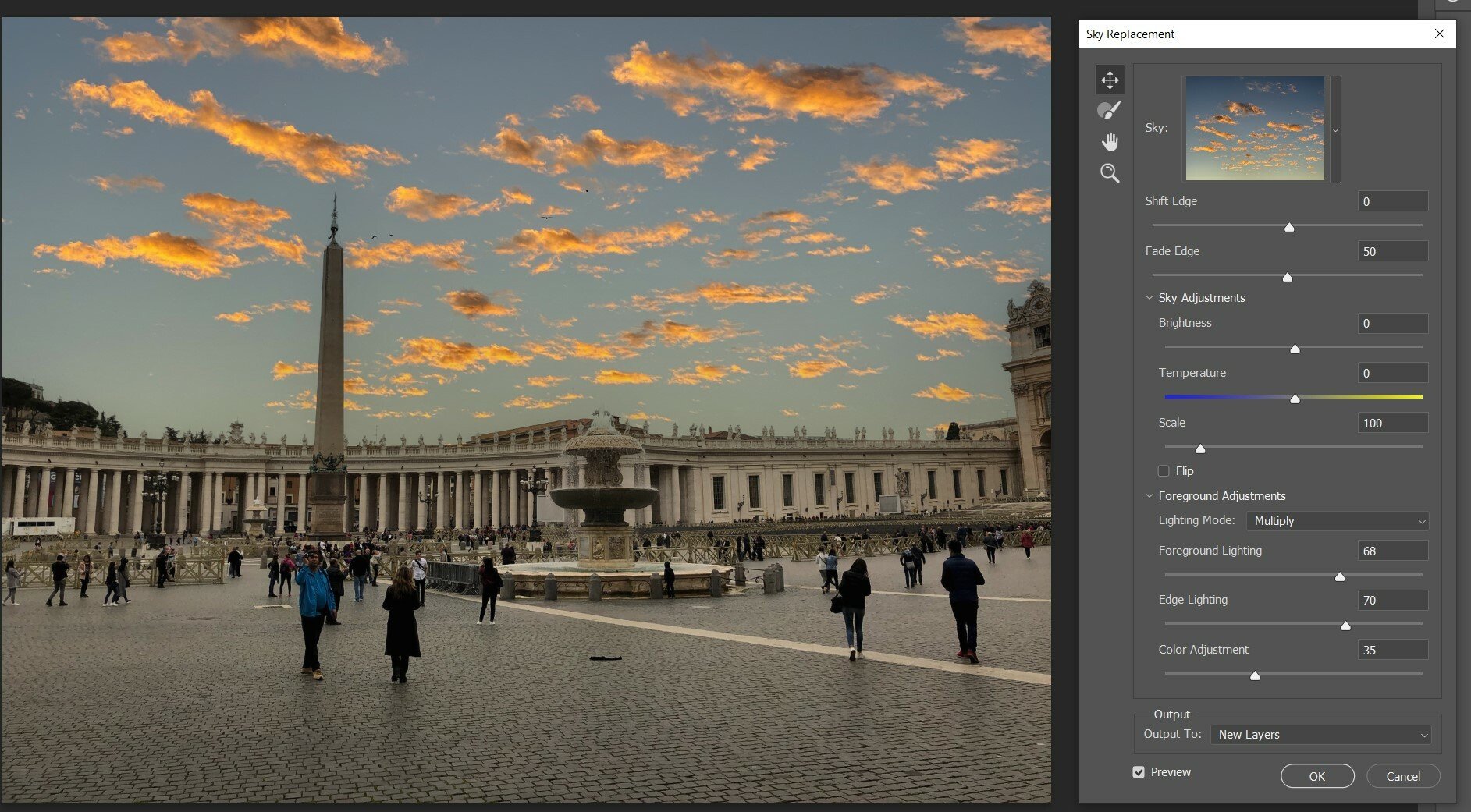 (Credit: Adobe/PCMag)
(Credit: Adobe/PCMag)Unlike some tools, which simply try to detect a horizon, Photoshop can handle images with foreground objects that block the sky, like the obelisk in the image above. You can move the sky around to get the best placement and even adjust the lighting and color of the foreground to better match the new sky. In the example, you can see how the pavement reflection changes to match the sky color.
Photoshop handles complex edges, such as tree lines, better than it did before. It does so by adding two adjustment layers and a "less-smooth mask than the compositing mask." Additionally, an Edge Lighting slider reduces the halo effects you get from using a bright sky on a dark existing area and vice versa.
Content-Aware Crop
Content-Aware Crop is a less creative and more natural version of the Generative Expand feature. You just check the Content-Aware box while using the crop tool, and the app fills in anything in the crop selection that falls outside your image's boundaries. Content-Aware Crop resembles the Content-Aware Fill tool in that it works well only with patterned image content, such as a forest, pavement, sea, or sky. It's particularly convincing with skies. Note in the image below how all the extra clouds in the sky on the right create a more spacious composition.
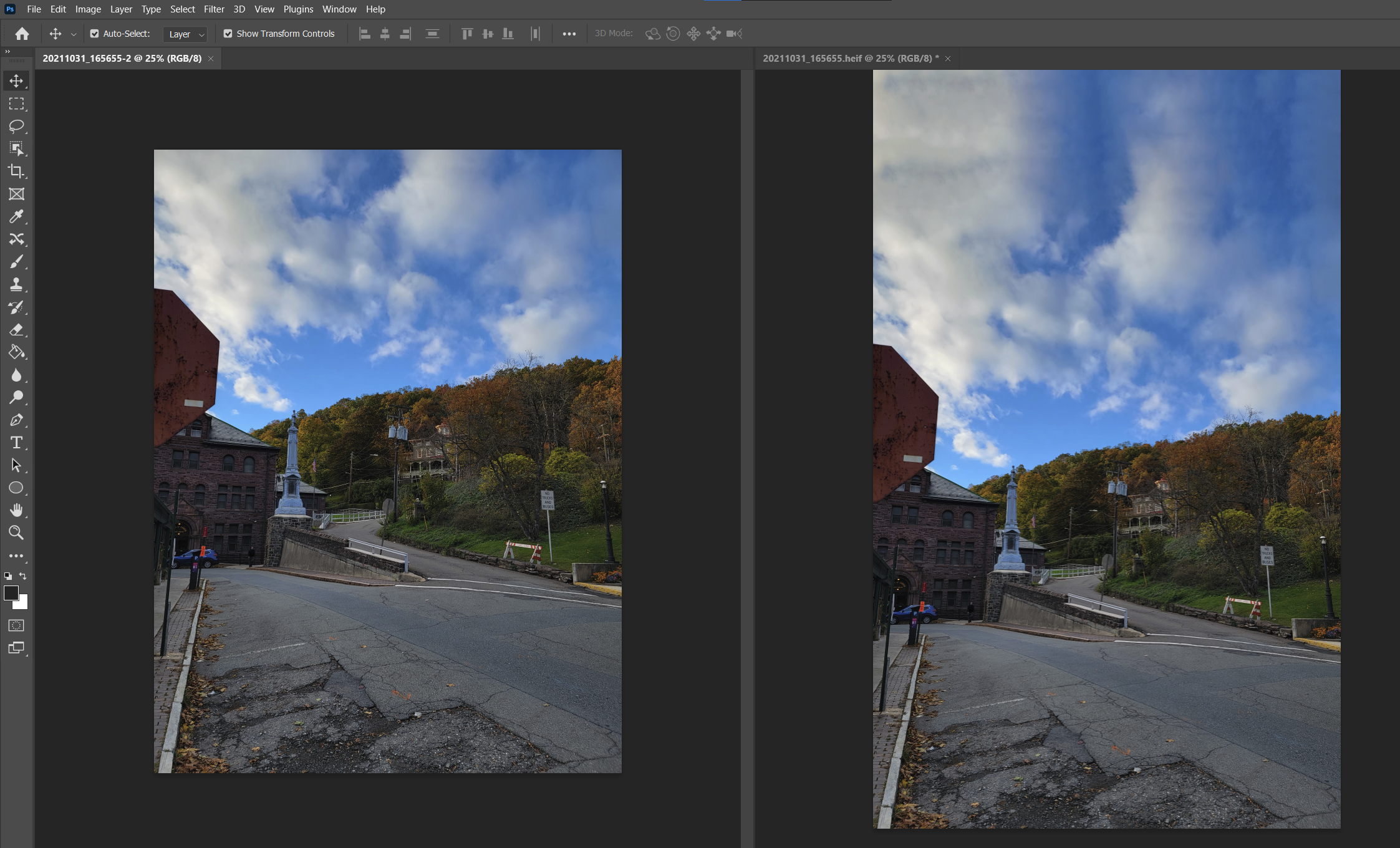 (Credit: Adobe/PCMag)
(Credit: Adobe/PCMag)The Content-Aware Fill interface shows you what source content Photoshop is using to replace the object you want to remove. You can edit the source area, but the program does a remarkable job with no help. It also identifies objects that shouldn't be part of the fill pattern.
A related tool is One Click Delete and Fill, which you use after selecting an object by pressing Shift-Backspace. Here's a shot in which I used this AI tool to remove the duck at the upper left.
 (Credit: Adobe/PCMag)
(Credit: Adobe/PCMag)It does a good job, but not a perfect one. You can still see a dark area where the duck was.
Face-Aware Liquify
Face detection has reached an increasingly high level of accuracy in recent years. Such tools can now identify individual facial features in addition to whole faces. Don't confuse it with face recognition, however, which identifies multiple images of the same person. Lightroom and other apps do this to help you organize your photo collection. Photoshop's Face-Aware Liquify tool uses face detection to let you convincingly transform facial expressions, turning, for example, a frown into a smile.
This brilliant tool finds facial features like eyes and mouths and gives you the ability to manipulate them with sliders for resizing the eyes, face width, jawline, and nose. You can even edit the eyes independently with Face-Aware Liquify. A chain icon lets you either lock editing of both of a subject’s eyes or edit them separately.
You can apply some very flattering changes or some ridiculously unflattering ones. For me, the coolest part of this feature is that the resulting image still looks human. It's not like simply smearing a portrait with the old-fashioned, face-unaware Liquify tool.
Camera Raw Features
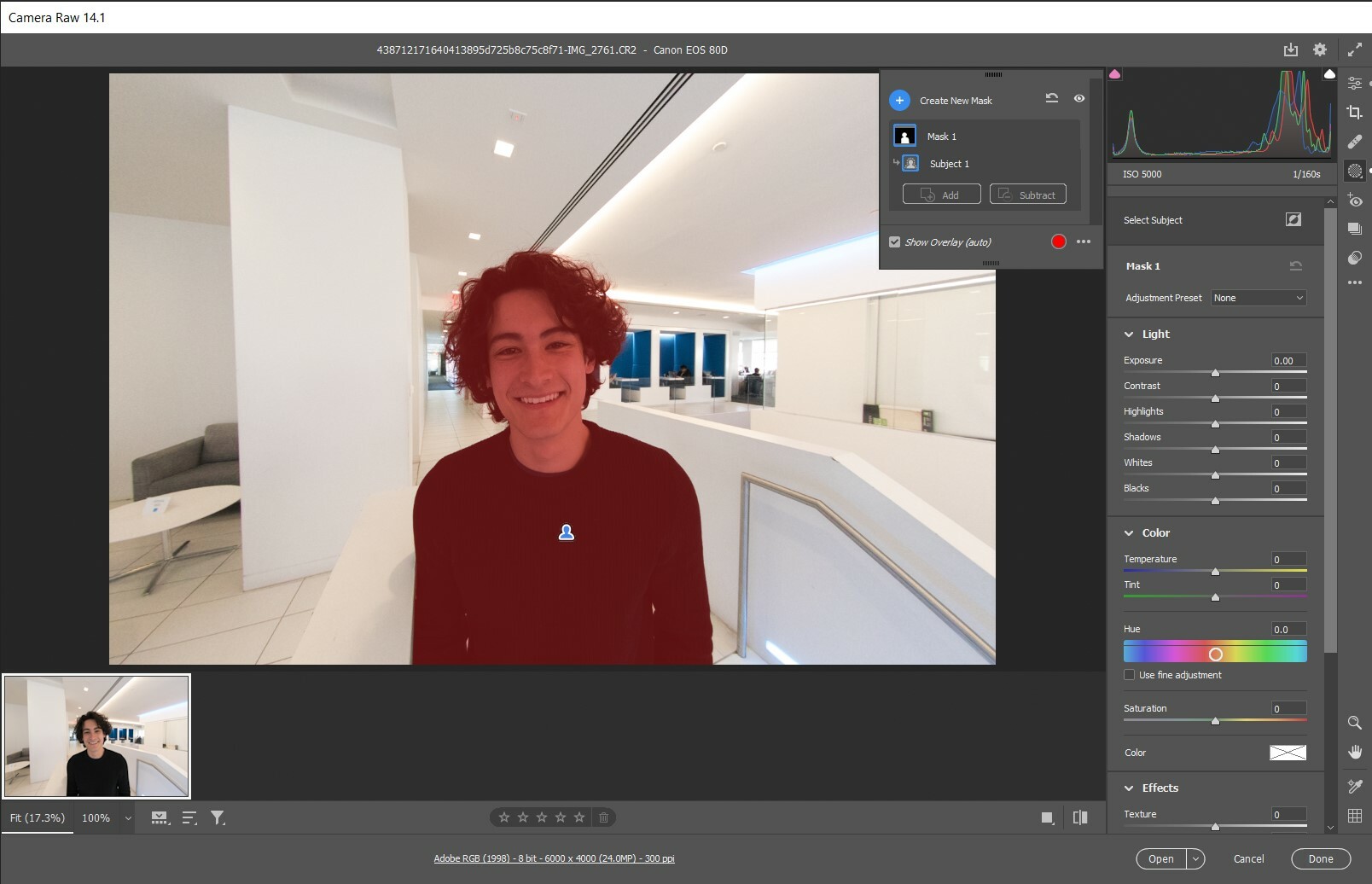 (Credit: Adobe/PCMag)
(Credit: Adobe/PCMag)The Adobe Camera Raw (ACR) module appears when you open raw camera files like Canon's CR3 and Nikon's NEF. This program seems to become more of a full photo editing tool with every update, and there's a good deal of overlap between what you can do in it and Photoshop itself. Even AI selection, healing, and masking tools are now in ACR. Think of Lightroom without the slick workflow features.
When Lightroom gets new features, they sometimes come to ACR rather than the main Photoshop interface. Examples are the Lens Blur tool, the Point Color tool, and support for HDR editing and output. For in-depth testing of the first two, check out my review of Lightroom. Below is the HDR button in ACR. You might be able to see the greater detail in the clouds on the right side. The histogram has a line in the middle, with everything on the right being in the HDR region. Note also the Visualize HDR and Preview for SDR display checkboxes further down.
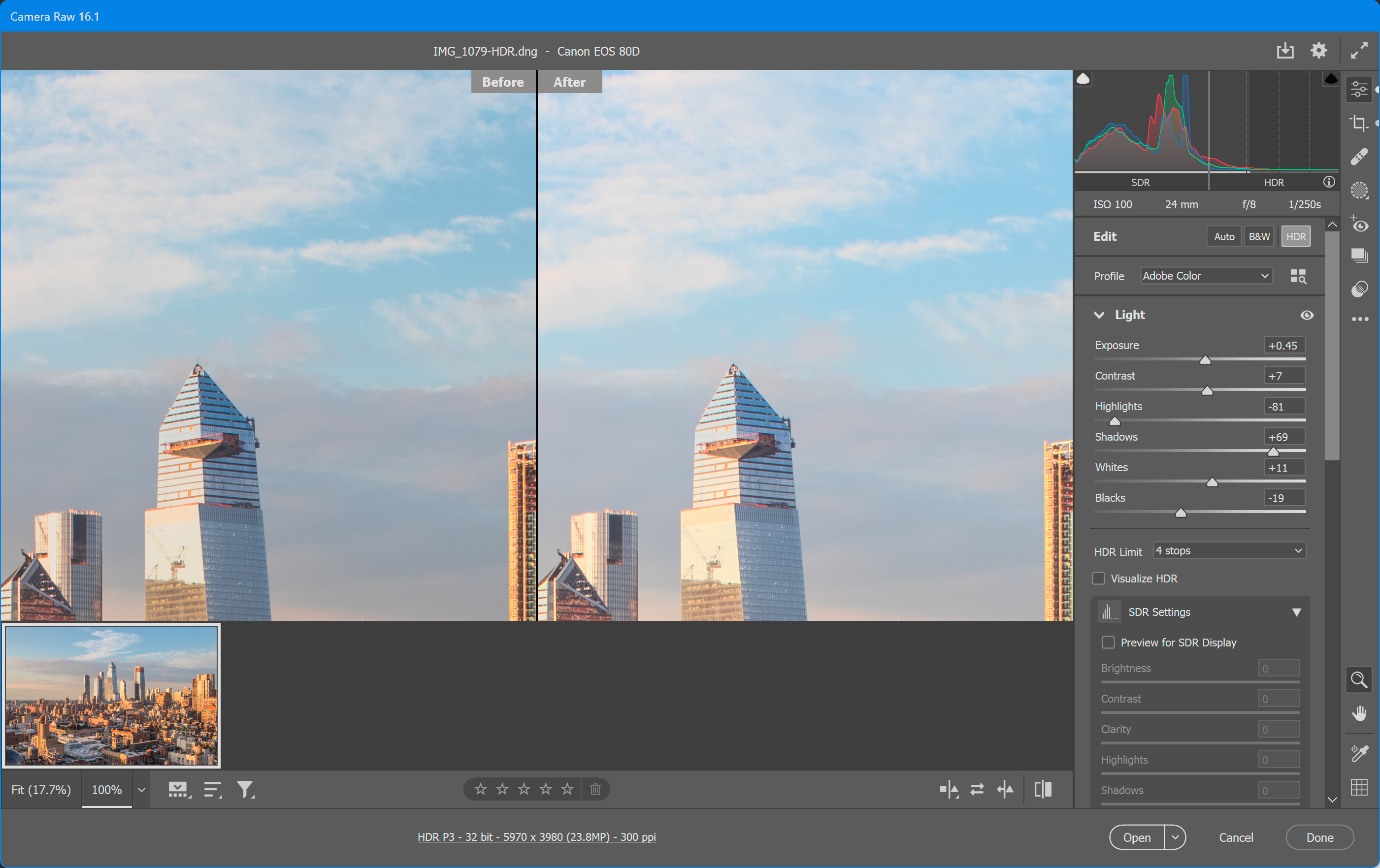 (Credit: Adobe/PCMag)
(Credit: Adobe/PCMag)To save to an HDR-compatible format, you don't open the image in the main Photoshop application. Instead, you have to click the down-arrow button to Save and Convert the image, where you can now choose JPEG XL and AVIF formats among myriad other settings. Although Photoshop is fairly capable for this kind of work, Lightroom and Lightroom Classic are better for it.
Below, you can see ACR's Point Color tool, which shifts a color range you select with a dropper. ACR now has no fewer than three tool groups that include the word Color: Color, Color Grading, and Color Mixer. The Point Color tool lives in the middle one, Color Mixer. Here, it was useful for toning down the overly rosy skin tones from the original colorization of the old photo below.
 (Credit: Adobe/PCMag)
(Credit: Adobe/PCMag)ACR lets you make local hue adjustments rather than changing the hue values for the whole image. It even includes the main program's Subject Select and masking tools. The tool lets you have more than one adjustment panel open, and you can switch between vertical and horizontal filmstrip thumbnail views. You can also create presets based on images' ISO settings and do panorama merges from a right-click.
As in Lightroom, you get the geometry correction tool called Upright in ACR. This lets you fix parallel vertical and horizontal lines. Its Auto setting attempts to fix perspective errors, but you can choose to align only verticals or only horizontals or mess with the perspective to taste with transforming sliders for pincushion and barrel distortion, vertical, horizontal, and aspect ratio.
Back in the main Photoshop interface, you can call up Camera Raw as a filter, applying all its manifold photo adjustments—such as color temperature, exposure, and geometry—to any image layer, not just to raw camera files. You can apply Camera Raw adjustments to videos, too, and use a non-circular healing brush. As in Lightroom, you get a radial filter that lets you apply the adjustments to an oval shape, such as a person's head.
The Camera Raw Profiles setting governs how Photoshop converts raw files into viewable images. The default is Adobe Color, which produces a more vivid image than the old Adobe Standard profile. You also get Landscape, Monochrome, Portrait, and Vivid Profiles, along with a selection of retro and artistic Profiles that are essentially Instagram-style effect filters. The same Profiles feature appears in Lightroom.
The module also now includes more than 100 presets from pro photographers in categories such as cinematic, future, portrait, travel, and vintage. An Amount slider in these presets lets you adjust their strength, and you now even get the adaptive subject presets that apply only to an automatic subject mask. Unfortunately, most of the presets use nondescript names like FT1, FT2, FT3, and so on. They're also a bit drab overall, with few—even in the Creative category—resulting in particularly striking effects. Even the Edgy presets are fairly tame, but there are enough choices that you're likely to find a look you like.
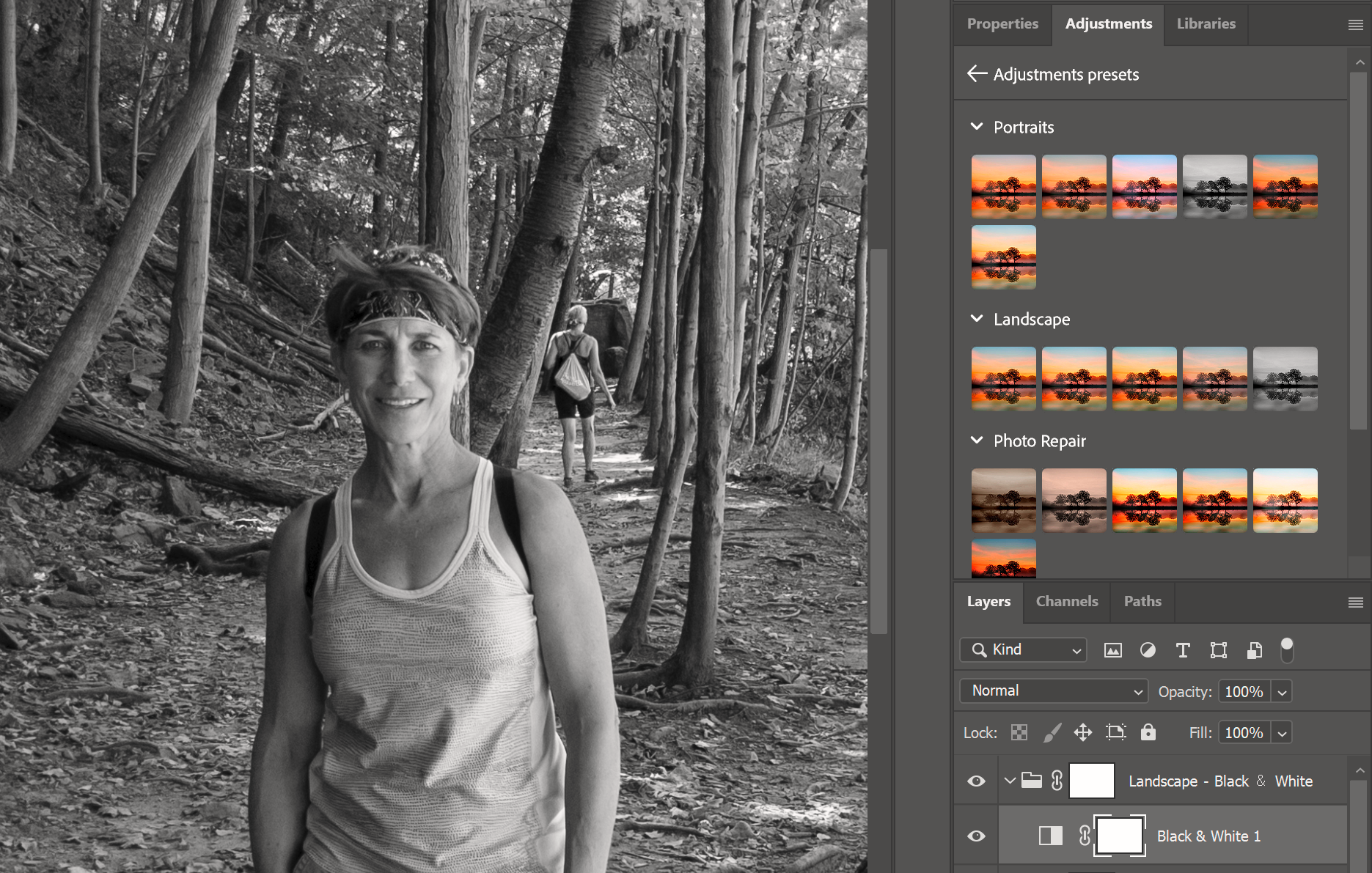 (Credit: Adobe/PCMag)
(Credit: Adobe/PCMag)You can save custom presets, which live in a group just below the built-in presets. You can then export these in .psap format.
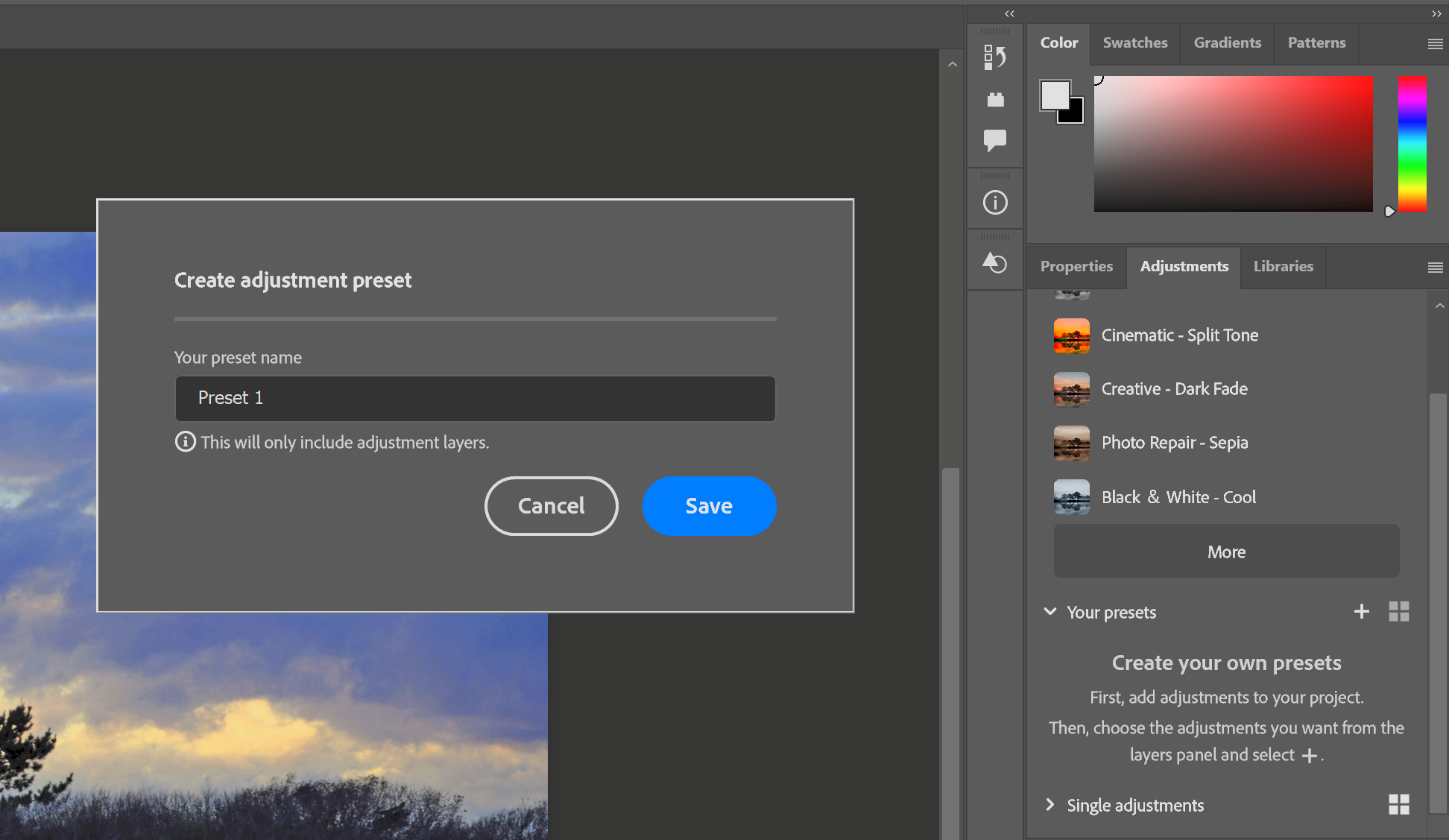 (Credit: Adobe/PCMag)
(Credit: Adobe/PCMag)Noise Reduction
Photoshop finally has automatic noise reduction, but it's not as effective as third-party software from DxO and Topaz. You find the feature in the Detail section of the Edit tool group on the right-side panel. I give a rundown here, but see my detailed tutorial on how to reduce noise in photos.
As in Lightroom, clicking Denoise opens a window that shows an area of your photo in close detail with the correction active. You can choose the strength with a slider; it defaults to 50. A progress circle fills up as the tool completes its work; on my test system, a 24MP raw file took about 10 seconds to denoise.
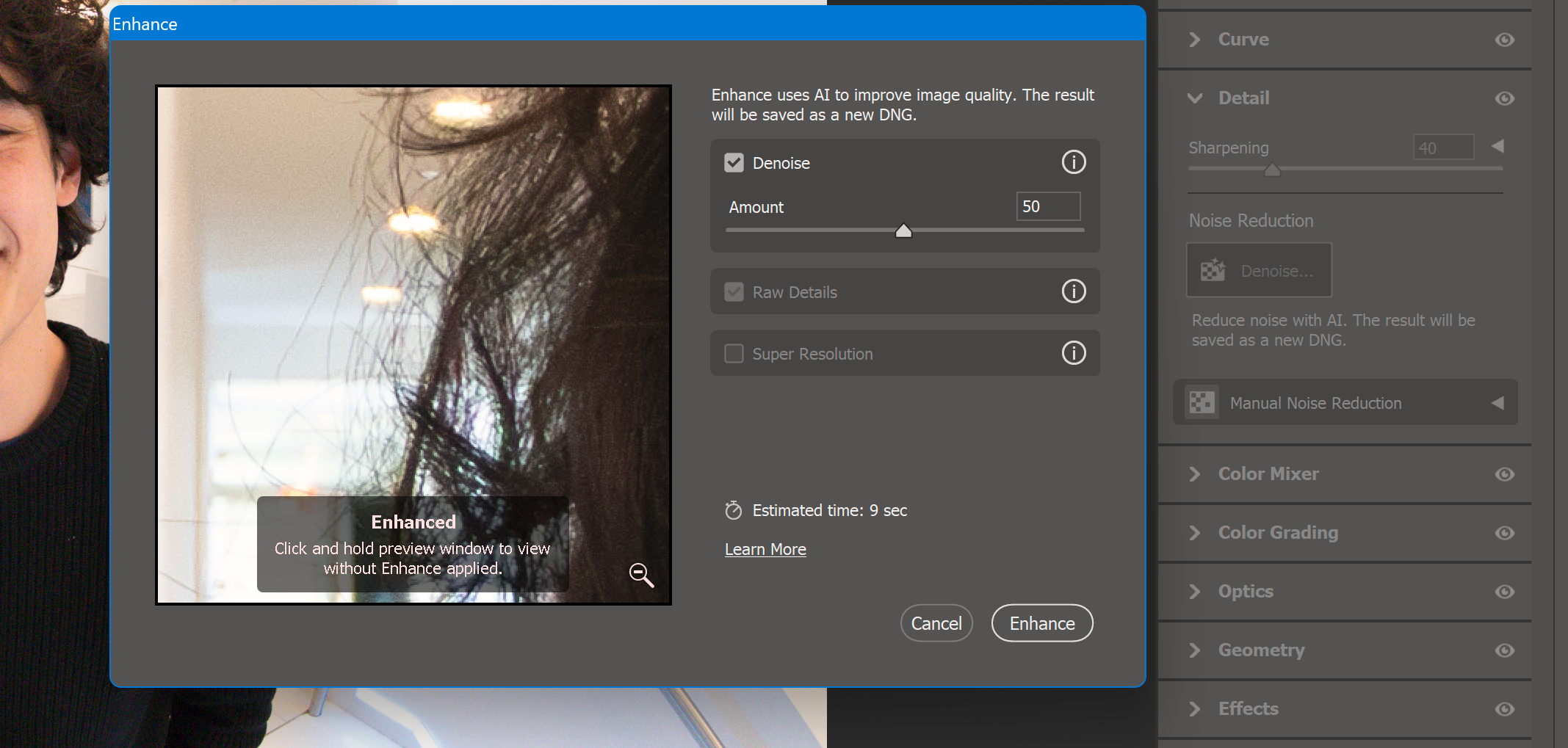 (Credit: Adobe/PCMag)
(Credit: Adobe/PCMag)Here's an example of the Denoise tool's work, with the original noisy shot on the left.
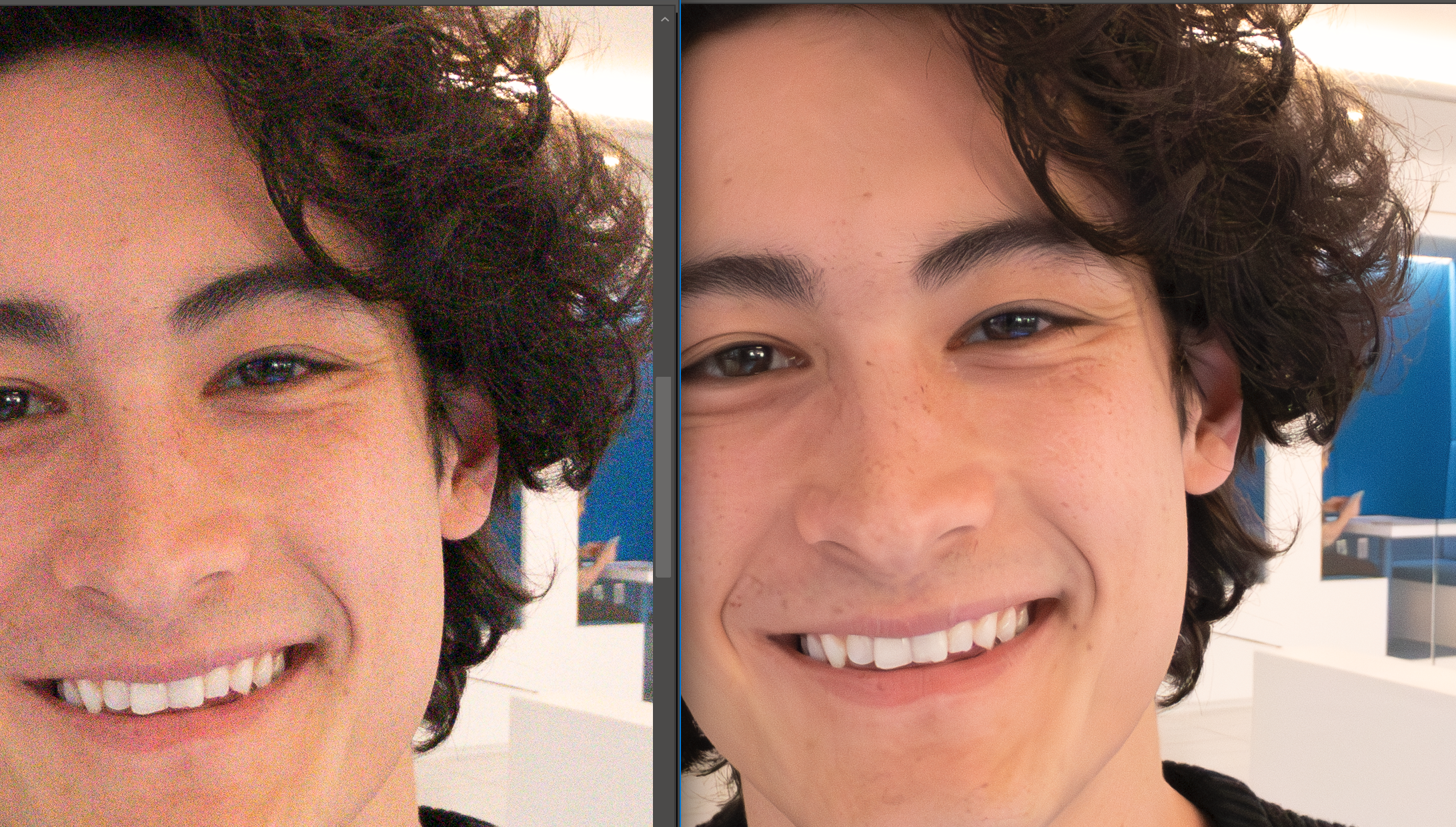 (Credit: Adobe/PCMag)
(Credit: Adobe/PCMag)Below is how the same originally noisy picture looks after I processed it in Photoshop (left), DxO PureRAW (middle), and Topaz DeNoise AI (right) using each program's default settings.
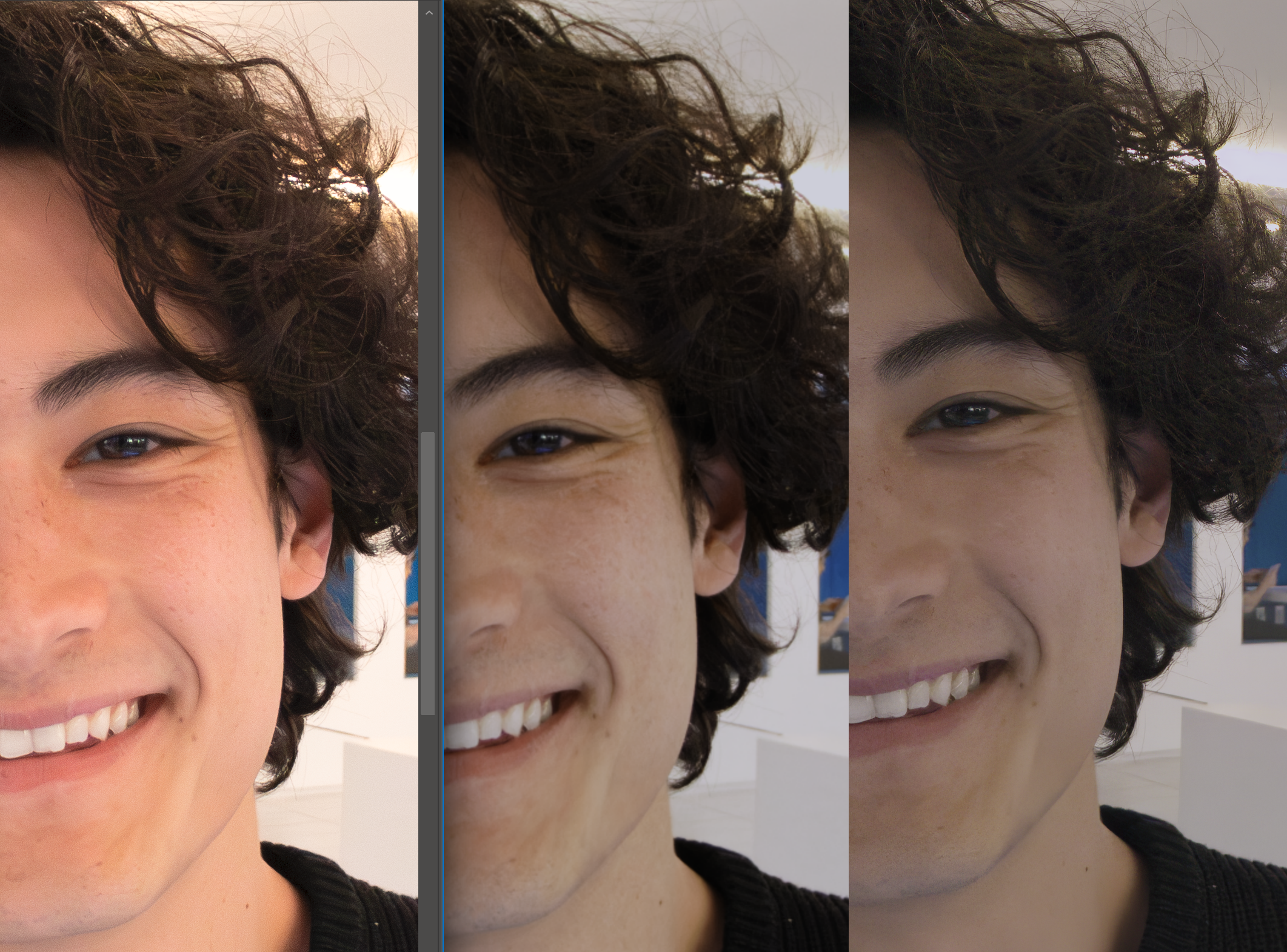 (Credit: Adobe/PCMag)
(Credit: Adobe/PCMag)The colors are more vivid in the Adobe result, but I'm not concerned with that; I'm looking for detail recovery in addition to noise removal. The eyebrow shows those factors most clearly, and Topaz restores the most detail. Adobe comes in second, and DxO is third. But if you look at the cheek below the eye, DxO retains more texture than the others. Any of the three results in a much better image than a non-denoised one.
New Adobe Camera Raw Features
Photoshop’s raw processor applet gets new features with the 2024 Adobe Max update, including Generative Remove and Generative Expand (see above), in case you don't want to open an image in the main editor interface for those AI tools and more. Perhaps more useful is that you can now use the Denoise and Super Resolution tools without having to create a new DNG file.
Improvements to Mobile Design Tools and Libraries
Photoshop has made great strides in mobile design. Not only can you use tools to facilitate mobile and web design, but you can also install the Adobe Preview mobile app and see how your project looks on those platforms. After installing and running the app on an iPhone, I initially got a connection error. I was trying to connect to the desktop by USB rather than Wi-Fi, though the Adobe documentation says both methods should work.
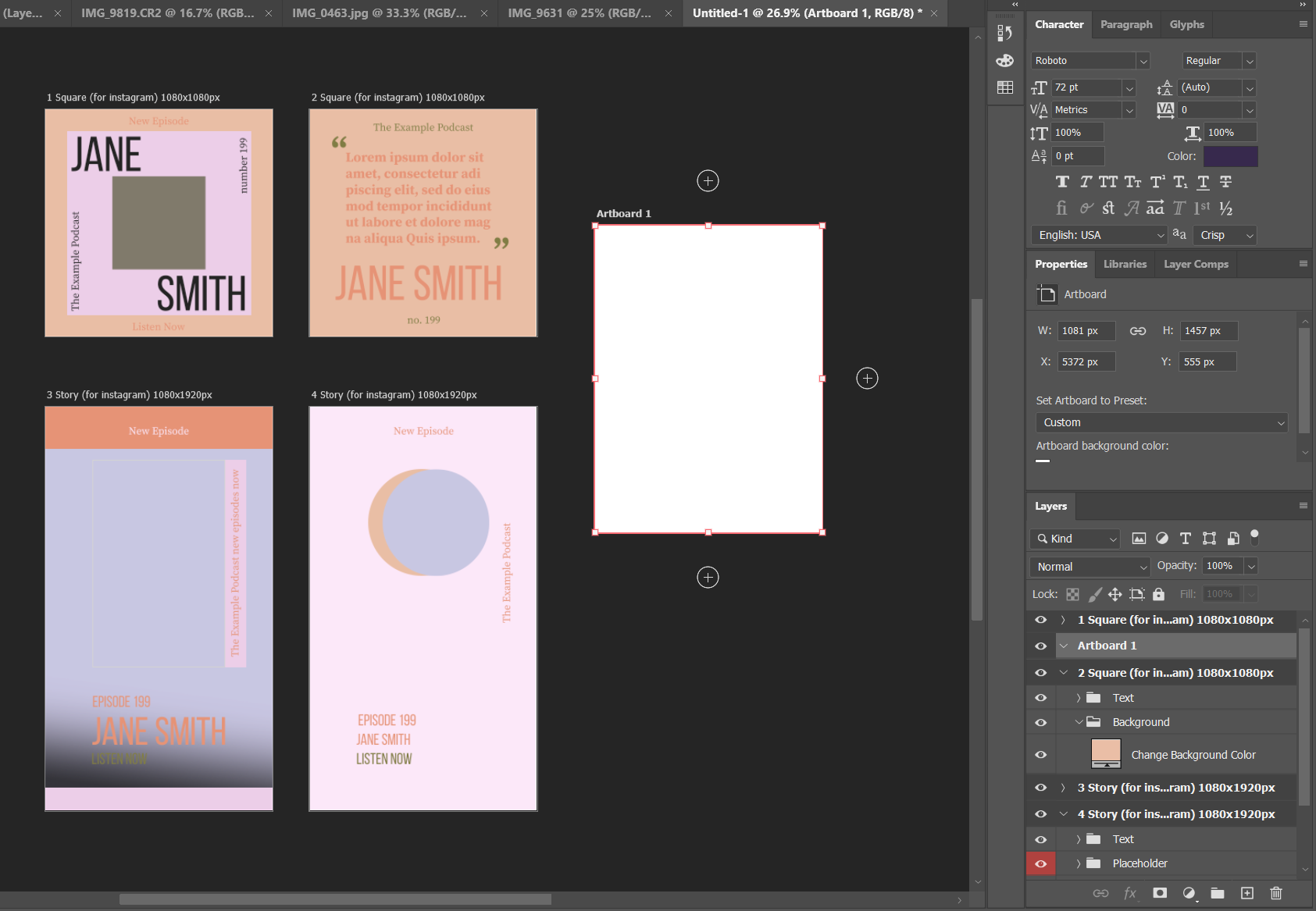 (Credit: Adobe/PCMag)
(Credit: Adobe/PCMag)Artboards let you create Photoshop documents with multiple views for different device screens. You can think of artboards as a level above layers, though they appear in the Layers panel. It sounds a little dry, but multi-platform designers will find them useful.
Shared Libraries sync not only documents but also brushes, color themes, and font styles. You can then access these in Adobe Express, Capture, and Fresco mobile apps. The Adobe mobile apps support Libraries for acquiring, creating, or editing content. They're all free downloads, but most require a Creative Cloud account for full functionality.
Related to Libraries are Cloud Documents. Saving your project as a Cloud Document enables you to work on it in the iPad version of Photoshop as well as on other desktops. The program saves Cloud Documents instantly, which support collaboration among multiple creators with an Invite to Edit option. You can also create a link (using the Share for Review feature button) to a web-hosted version of the photo where collaborators can comment. Previous versions of Cloud Documents show up in a Version History panel. Cloud documents support offline editing.
Fantastic Font Tricks
Photoshop keeps getting better at fonts. It automatically downloads and activates your document's fonts, as well as syncs them to your Library. You can also filter searches for fonts with attributes like blackletter, serif, and script. Another option is to tell the program to show you fonts similar to the one you've selected.
An update to the Contextual Task Bar now suggests text formatting edits, including alignment, font, kerning, and size.
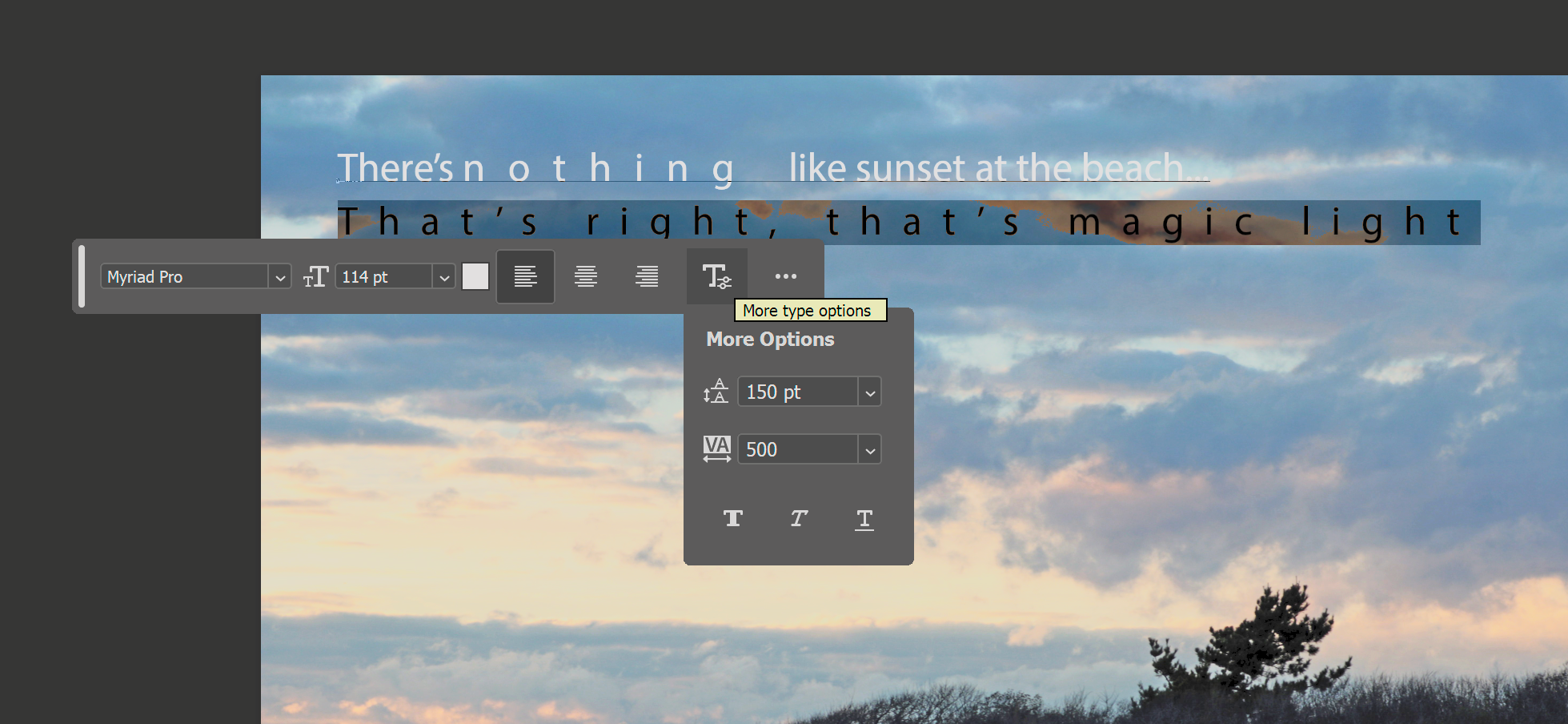 (Credit: Adobe/PCMag)
(Credit: Adobe/PCMag)And the Font browser lets you hover over a font in its panel and see live changes to the on-canvas font.
 (Credit: Adobe/PCMag)
(Credit: Adobe/PCMag)The Type > Match Font tool can identify fonts in images and find the closest match on your system or in Adobe's massive font collection. Its intelligent imaging analysis recognizes more fonts than before, as well as can detect text that is vertical or shows up across multiple lines. This tool now works better than before.
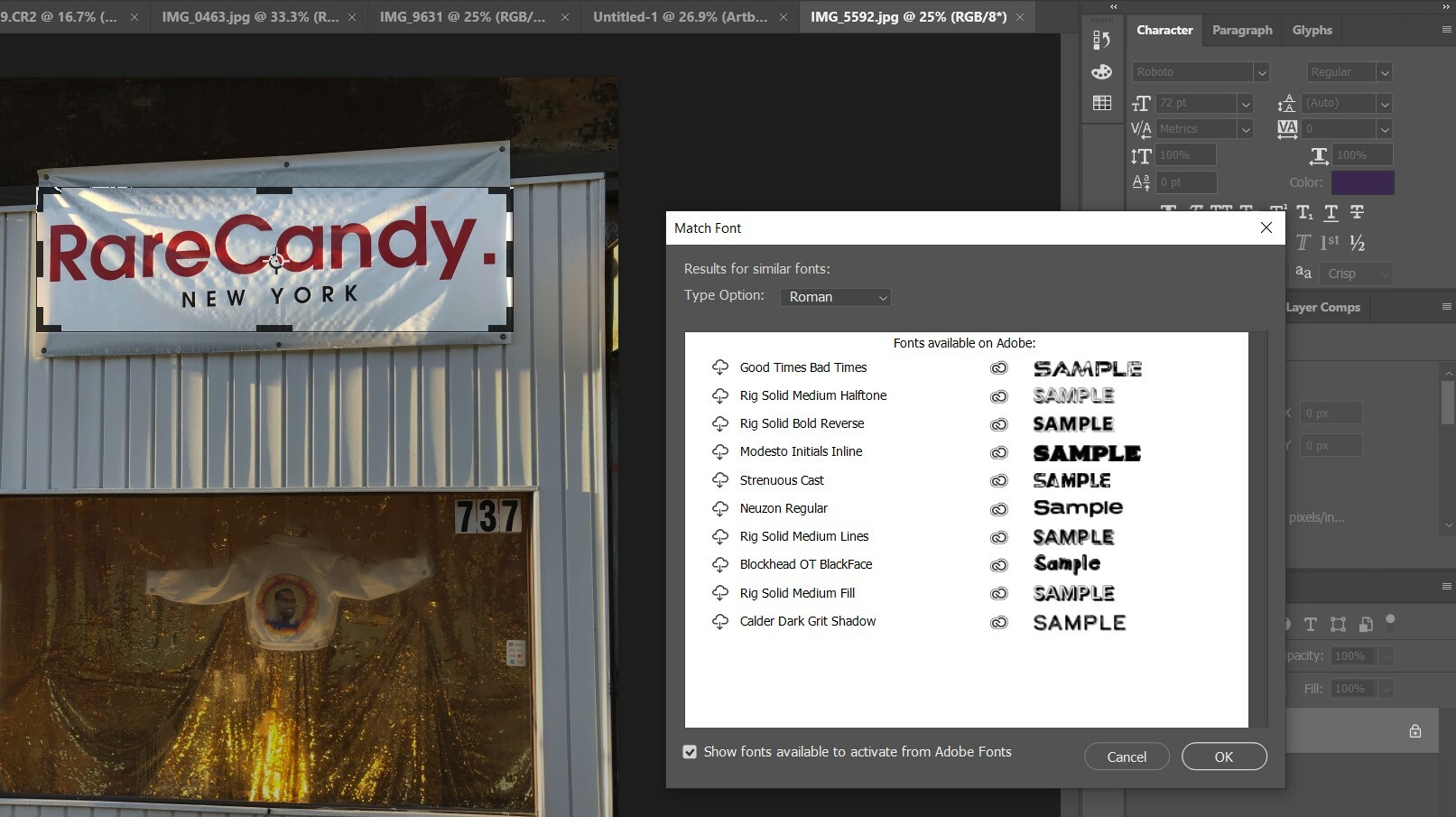 (Credit: Adobe/PCMag)
(Credit: Adobe/PCMag)You can also designate fonts as favorites. The font size drop-down menu gives you a 16-point option, a size common for web content. Web designers will also rejoice now that Photoshop supports SVG OpenType fonts for those wildly popular responsive designs, as well as emoji fonts. You can search fonts.adobe.com for typefaces; everything is licensed, thanks to your Creative Cloud subscription.
Font fanciers who want to go beyond standard typeface sets will love the Glyphs panel. It lets you substitute alternate characters and even shows you those alternates when you select a character in a Type layer. The tool didn't always work reliably for me, though, sometimes proposing a previous letter when I selected a new one.
A welcome option for the Type tool is list creation of both the bullet and numbered varieties. You get several styles to choose from for each, including dashes instead of bullets and letters instead of numbers.
Photoshop also supports Variable Fonts, an OpenType font format that lets you play with custom attributes like optical size, slant, weight, and width using slider controls. It now also uses the Unified Text Engine to replace the legacy text engines and allows more flexibility with non-Latin characters.
Lots of Tools for Artists and Designers
With higher-resolution displays becoming more common, your old images sometimes might not be good enough anymore. Photoshop's upsampling algorithm could be a lifesaver. The upscaler shows up when you resize an image in the form of the Preserve Details resample setting. It also has a Reduce Noise option since the process might introduce noise. It's much clearer than the old bicubic algorithm.
Smart Objects make for nondestructive, reusable raster and vector images that update throughout your project. You can save formatting of type as styles that you can easily apply to other text later. You can also view type in a way that previews the antialiasing that web browsers use. For web designers, Photoshop can generate CSS code that produces the exact look you created in the software. The software can also do the reverse, importing color from a website's HTML or CSS code.
Converting Smart Objects back to their components for editing is now a simple matter of using the Convert to Layers menu option. Adobe updates the default gradients, patterns, shapes, styles, and swatches with more appealing options. Below, you can see the gradient panel on the right, for example.
Turbocharged Gradients
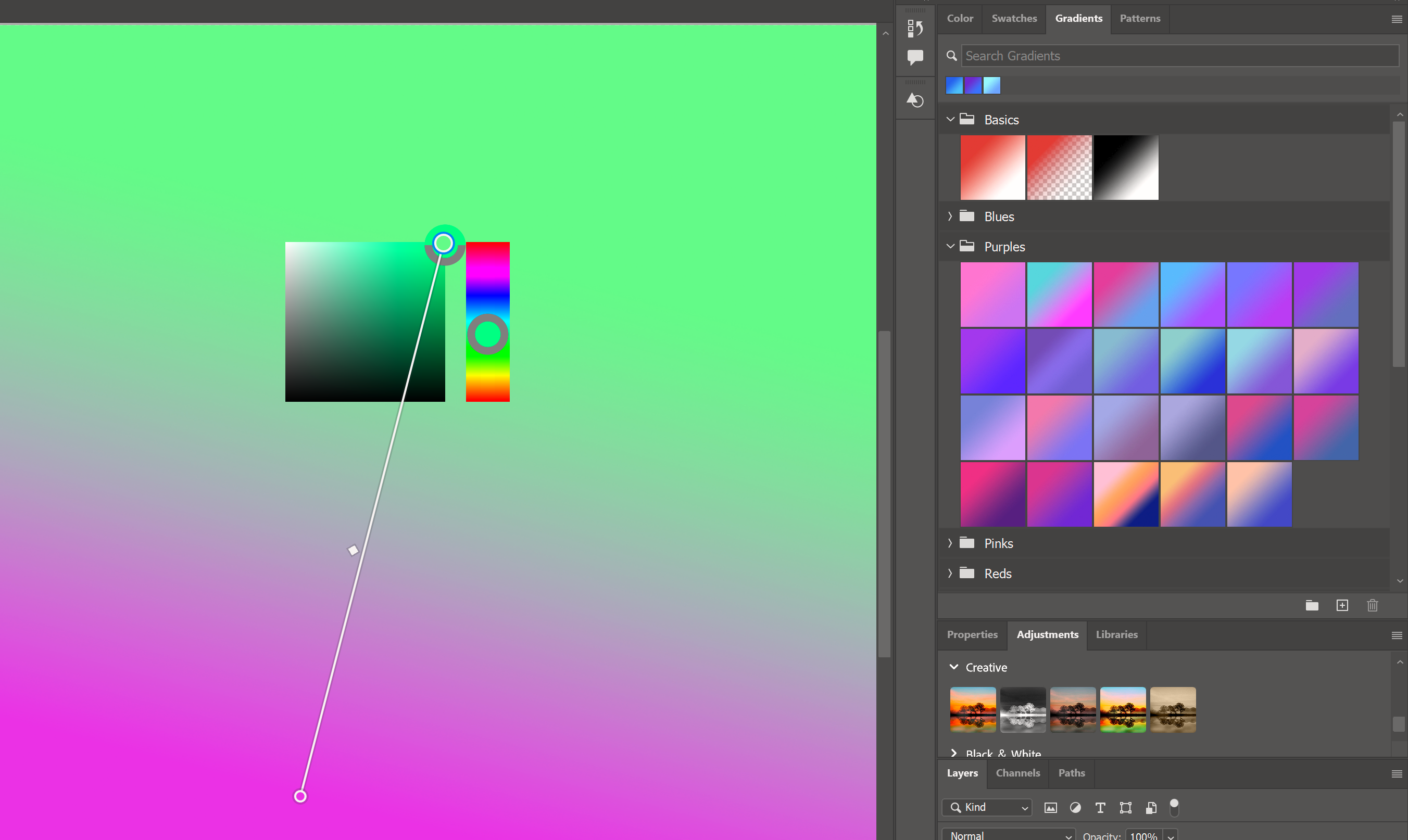 (Credit: Adobe/PCMag)
(Credit: Adobe/PCMag)Adobe has updated gradients in the past few years, notably adding options like Perceptual and Linear interpolation modes. You now get a center point to adjust as well as the endpoints. You can also right-click on either endpoint to choose a new color or double-click to open the full color picker. Changes show up live as you work, which makes the gradient tool super powerful and customizable—it's a lot of fun to play with.
Brushes and Pencils
Photoshop offers more than 1,200 brushes and pencils. They give you stroke smoothing options, and you can organize brush presets in folders. A recent capability is the Symmetry option. It works with the Erase, Mixer Brush, Paint Brush, and Pencil tools. To use it, click the butterfly icon in the Options bar and choose the kind of symmetry you want: Circle, Diagonal, Dual Axis, Horizontal, Mandala, Parallel Lines, Radial, Spiral, Vertical, or Wavy.
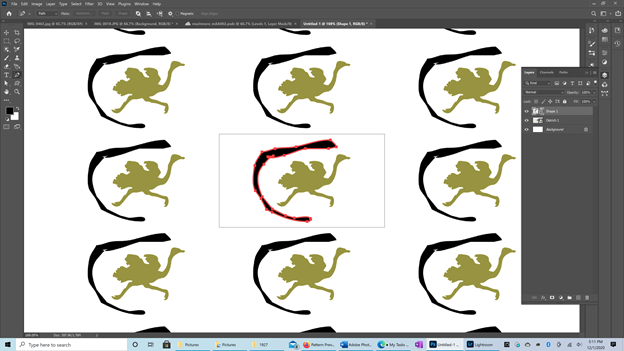 (Credit: Adobe/PCMag)
(Credit: Adobe/PCMag)A Pattern Preview feature simply repeats whatever is in your image as a grid—outside the actual image boundary. You can then save the result as a reusable pattern. (As you can see, I’m no artist.) It seems like a great tool for designing wrapping paper and greeting cards.
Alternatively, you could use the Line and Shape tools from the left-hand toolbar. Adobe lets you draw raster lines as pixels, and designers can now import Illustrator files complete with vector masks, paths, and shapes. Before, you could draw vector lines only, which makes more sense unless you're going for a pixel art effect. Now, you can import text layers from Illustrator that maintain vector art and the ability to edit the font. Previously, Photoshop would have converted them to raster objects.
Adjustment Brushes
One of Adobe's latest brushes is the Adjustment brush. Though this is photography-oriented, it appears in the regular Photoshop interface rather than in Camera Raw. It adds a layer (making your edits with it non-destructive), and you choose Brightness, Curve, Exposure, Hue/Saturation, Levels, Photo Filters, Vibrance, and more. Here, I used it to create a blotchy pattern on the sweater with the Brightness function.
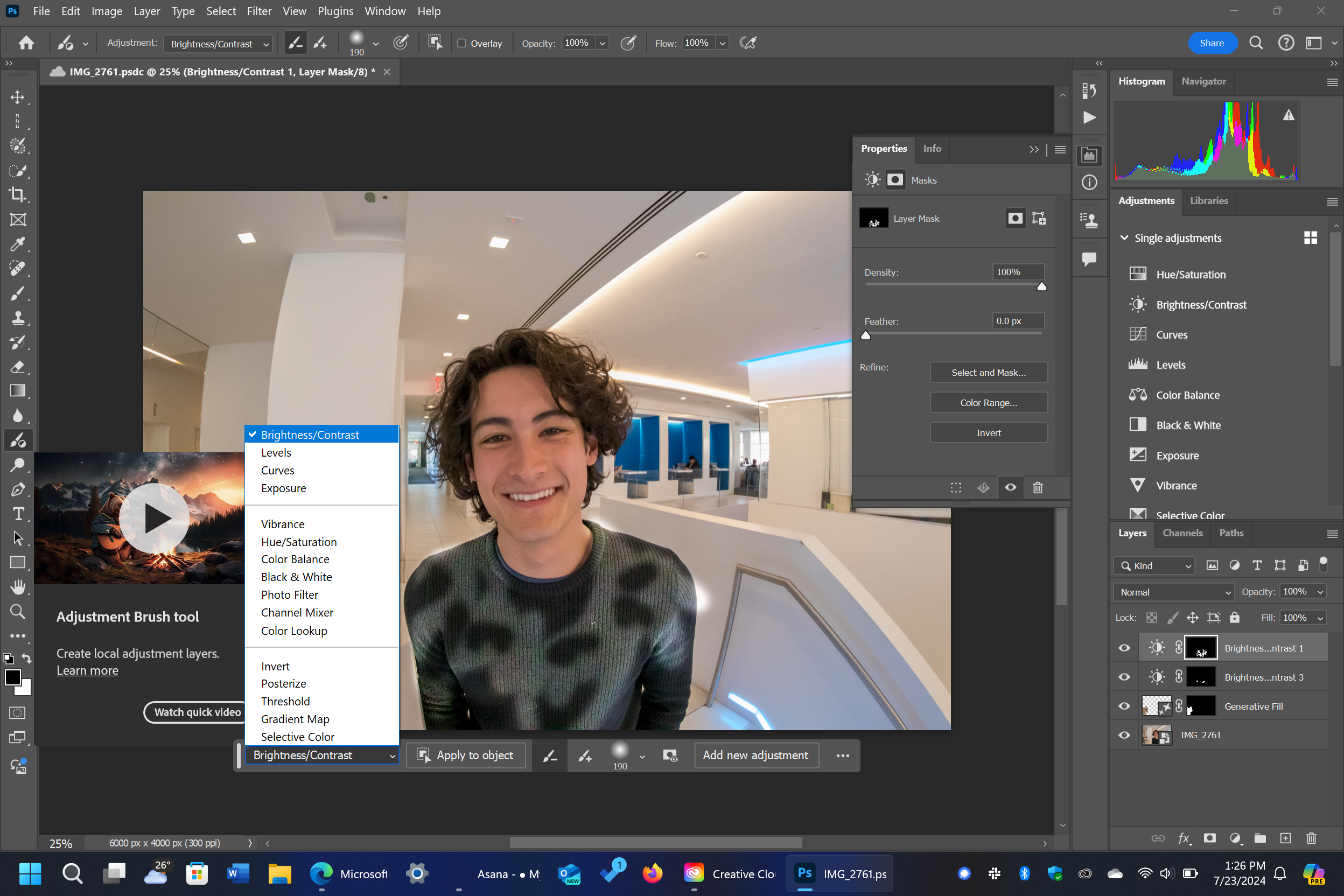 (Credit: Adobe/PCMag)
(Credit: Adobe/PCMag)Extensive Export and Sharing Options
Photoshop's Export options are richer than ever, and the process is faster. It supports the operating system's share feature, which opens macOS and Windows' built-in share targets. On the Mac, you can use AirDrop. In Windows, you can use Nearby sharing, as well as any other installed Store apps that accept photos.
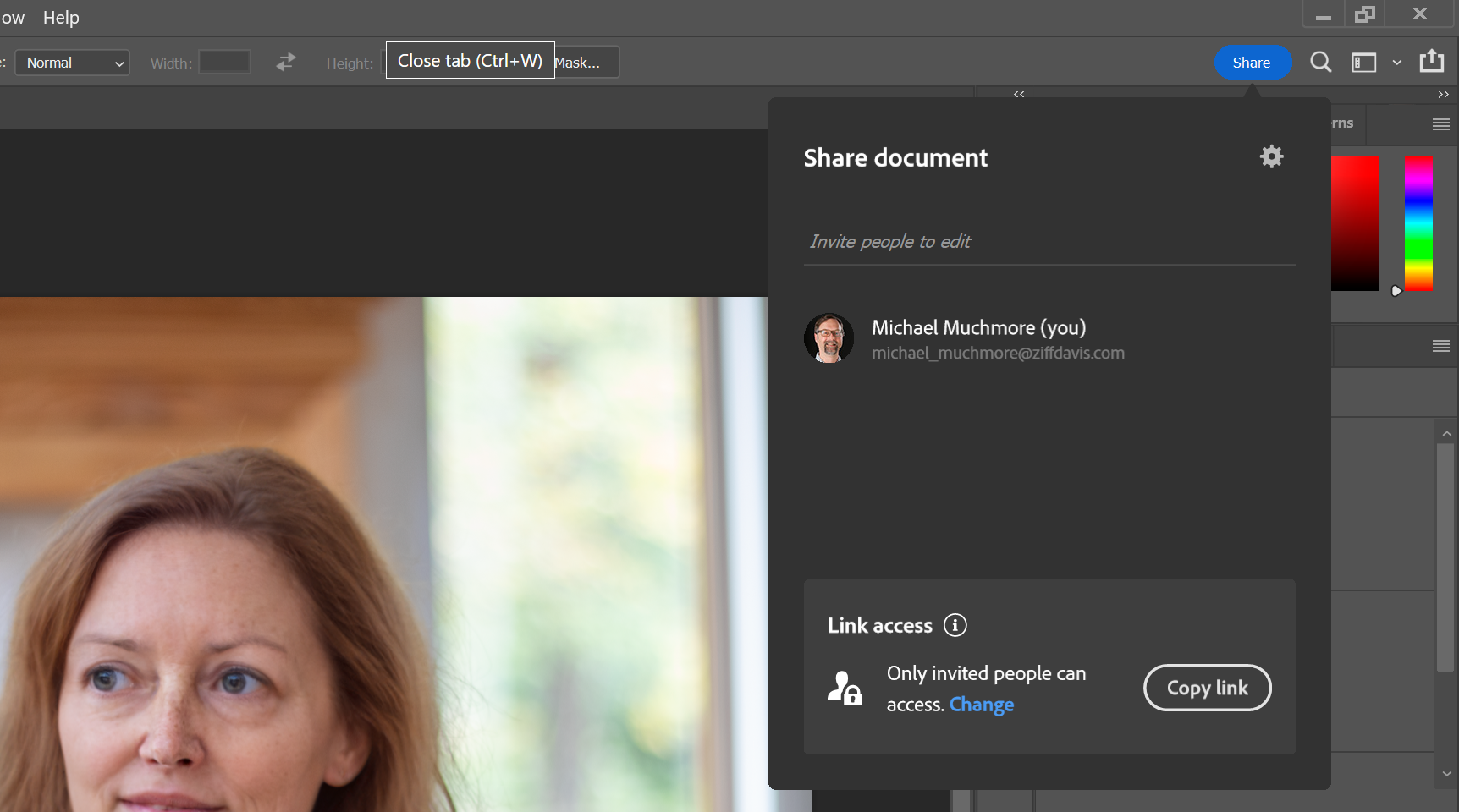 (Credit: Adobe/PCMag)
(Credit: Adobe/PCMag)A big Share button lets you invite co-editors to work on Adobe Cloud Documents. You can either specify the user's Adobe ID email address or copy a sharing link. You can include a comment for your collaborators, too.
The Export option replaces the tried-and-true Save for Web option, though you can still use that if you prefer. It's faster, and it delivers smaller files, especially when it comes to JPGs. You can also export and import SVG (scalable vector graphics) files, which are common for websites. You can even now export images in Google's web-friendly WebP format.
Photoshop lets you export at multiple sizes simultaneously, convert to the sRGB color space, and export a single layer or Artboard. You can use the format of your choice by setting up a Quick Export option from the File menu. Finally, you can add metadata, such as copyright information, at export.
Can Photoshop Root Out Deepfakes?
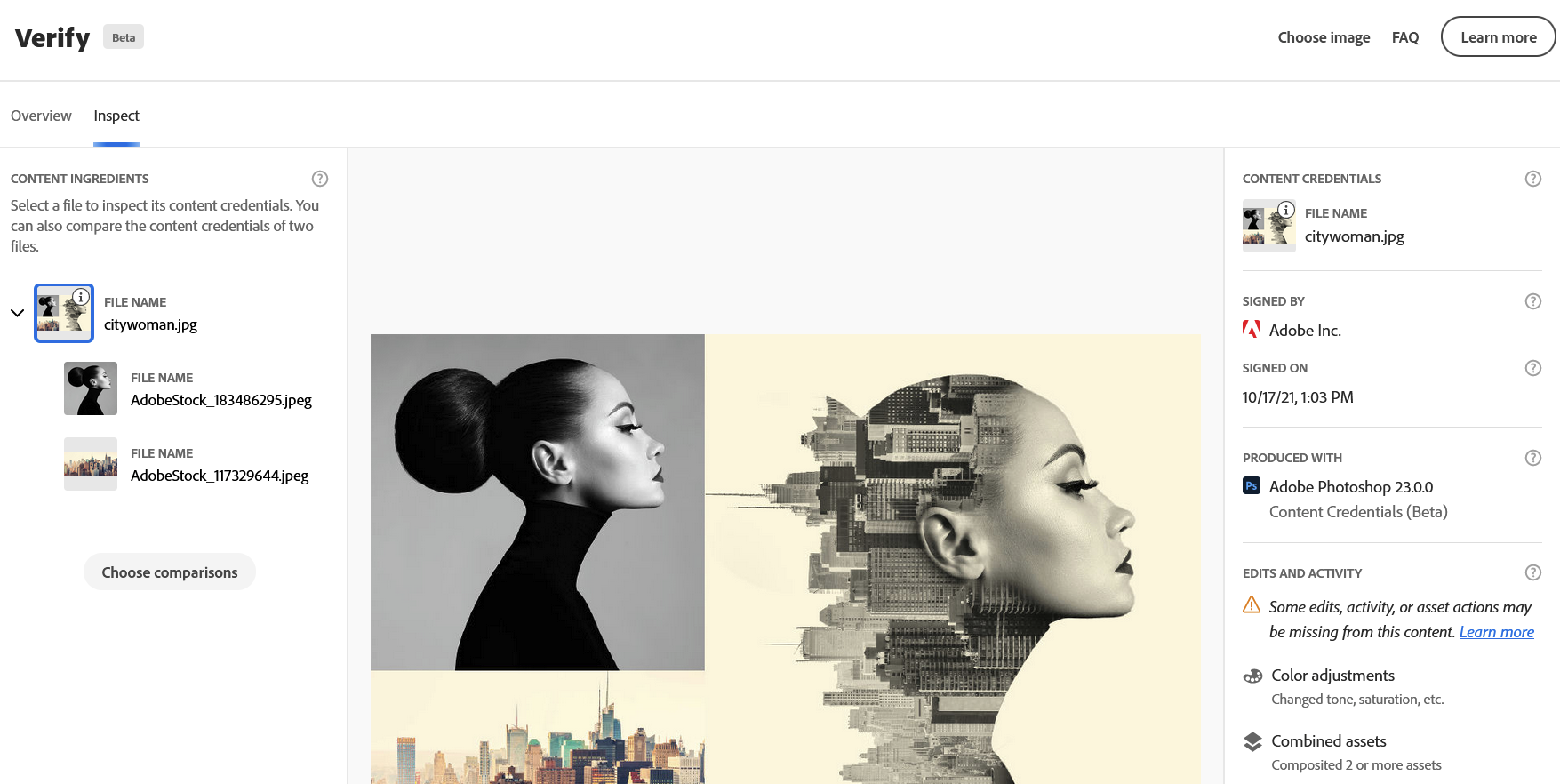 (Credit: Adobe/PCMag)
(Credit: Adobe/PCMag)One feature worth mentioning is Content Credentials. This tool ties in with the Coalition for Content Provenance and Authenticity (C2PA) proposal. It records tamper-evident proof of any edits one makes to an image and verifies the identity of its creator. It also makes the information available on the public Verify website, where you can check an image's provenance. Adobe's Behance social sharing site also supports Content Credentials for validation of images' authenticity.
Verdict: Photoshop Goes Far Beyond Photo Editing
Photoshop makes it easy to do amazing things with digital images and benefits from an expanding selection of Firefly generative AI tools that keep it on the cutting edge. Adobe continues to improve help features too, a boon for such a feature-rich program. You won't find photo editing software with more comprehensive or precise tools for drawing, photo manipulation, and typography. Photoshop's position as the preeminent image editing tool remains secure, so it receives a rare five-star rating and our Editors' Choice award. If you want the best photo workflow software for importing and organizing your photo collection, look to Adobe Lightroom Classic, another Editors' Choice winner.

